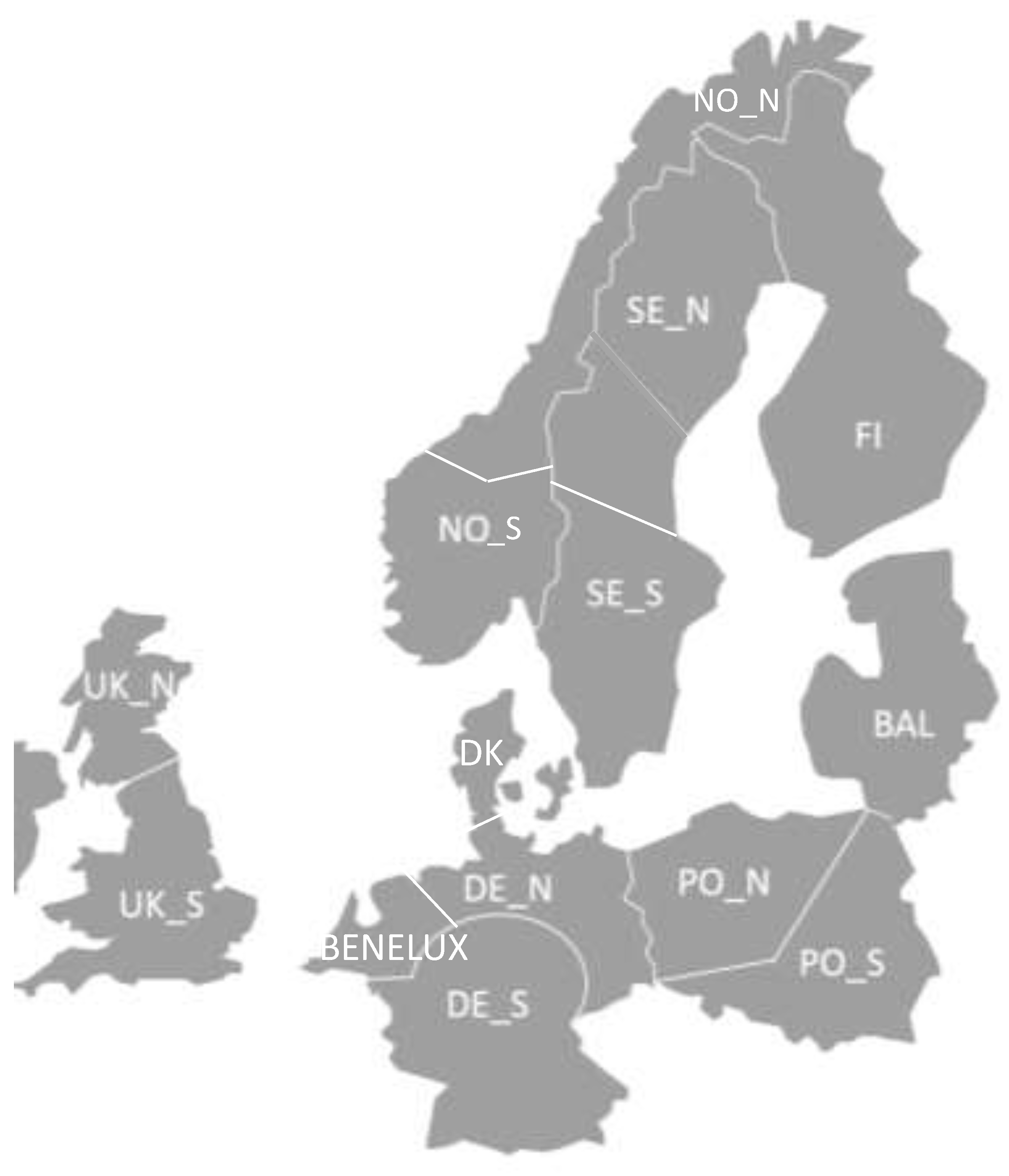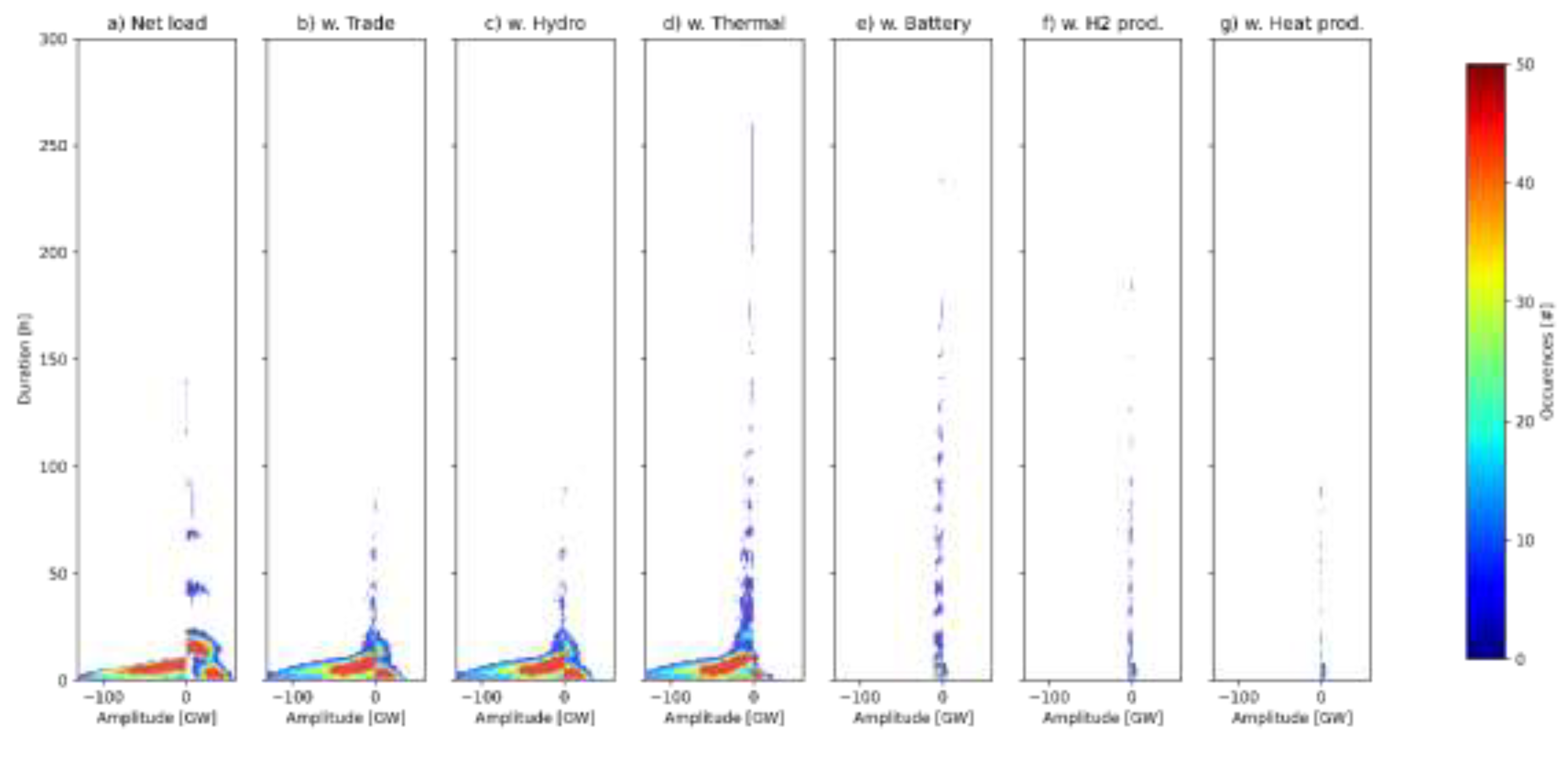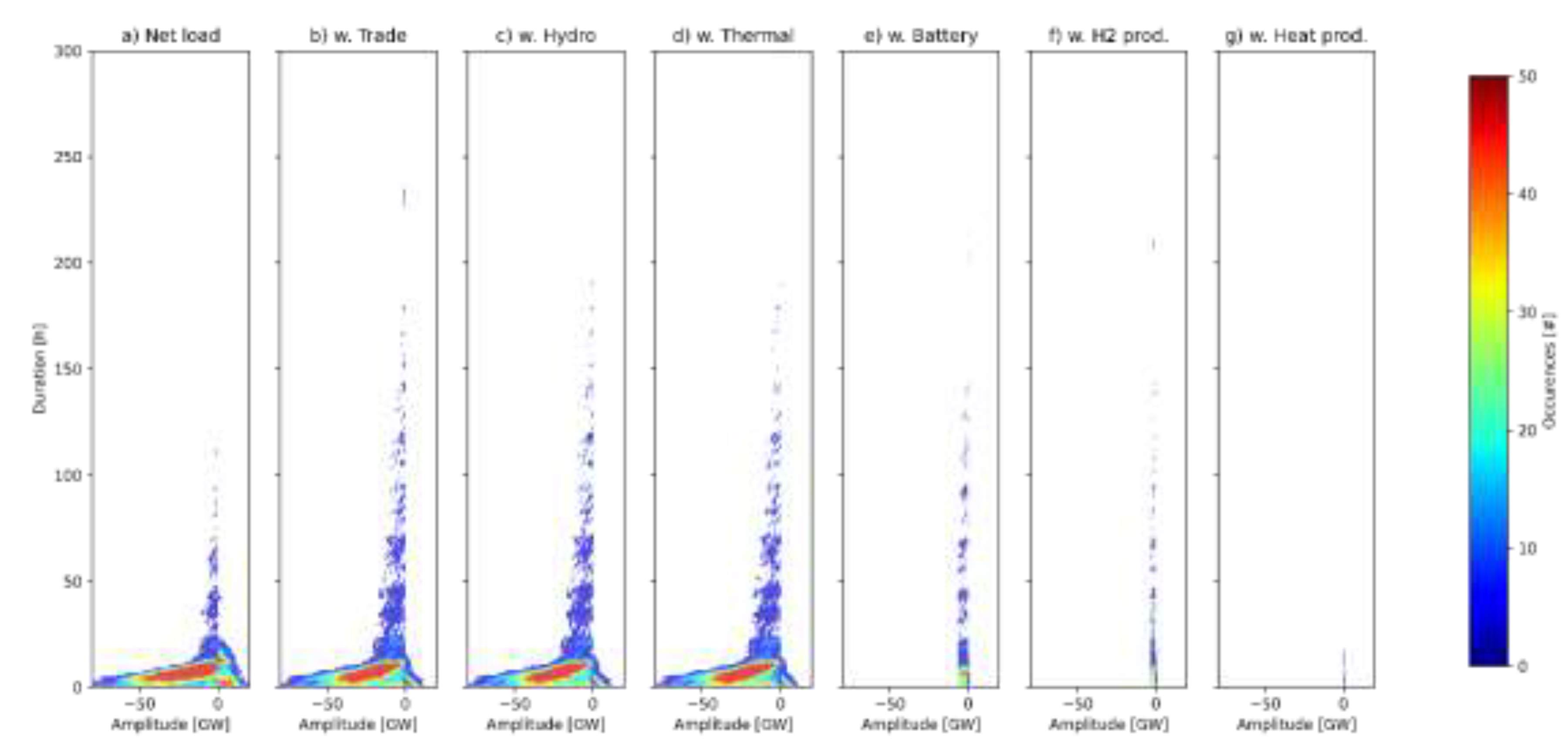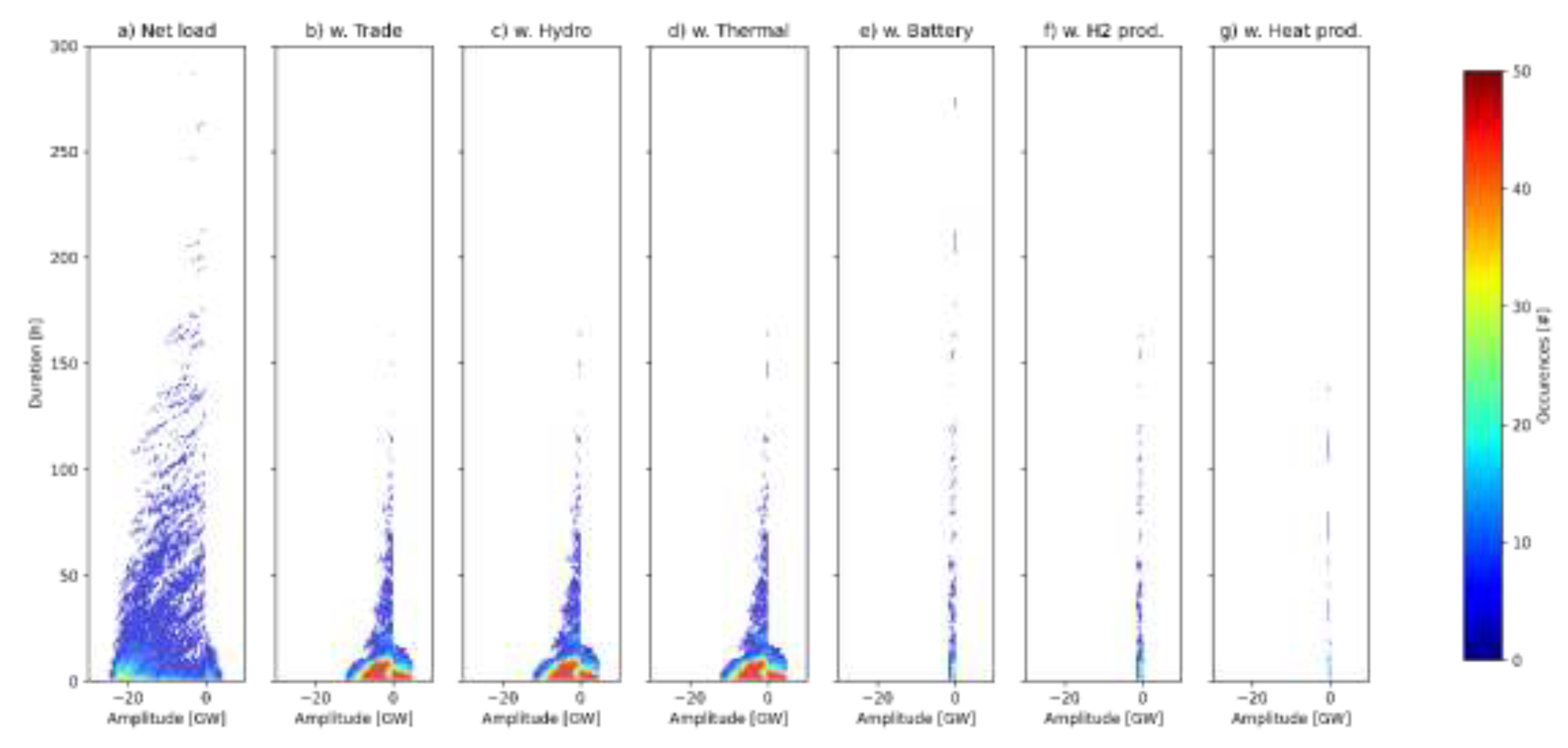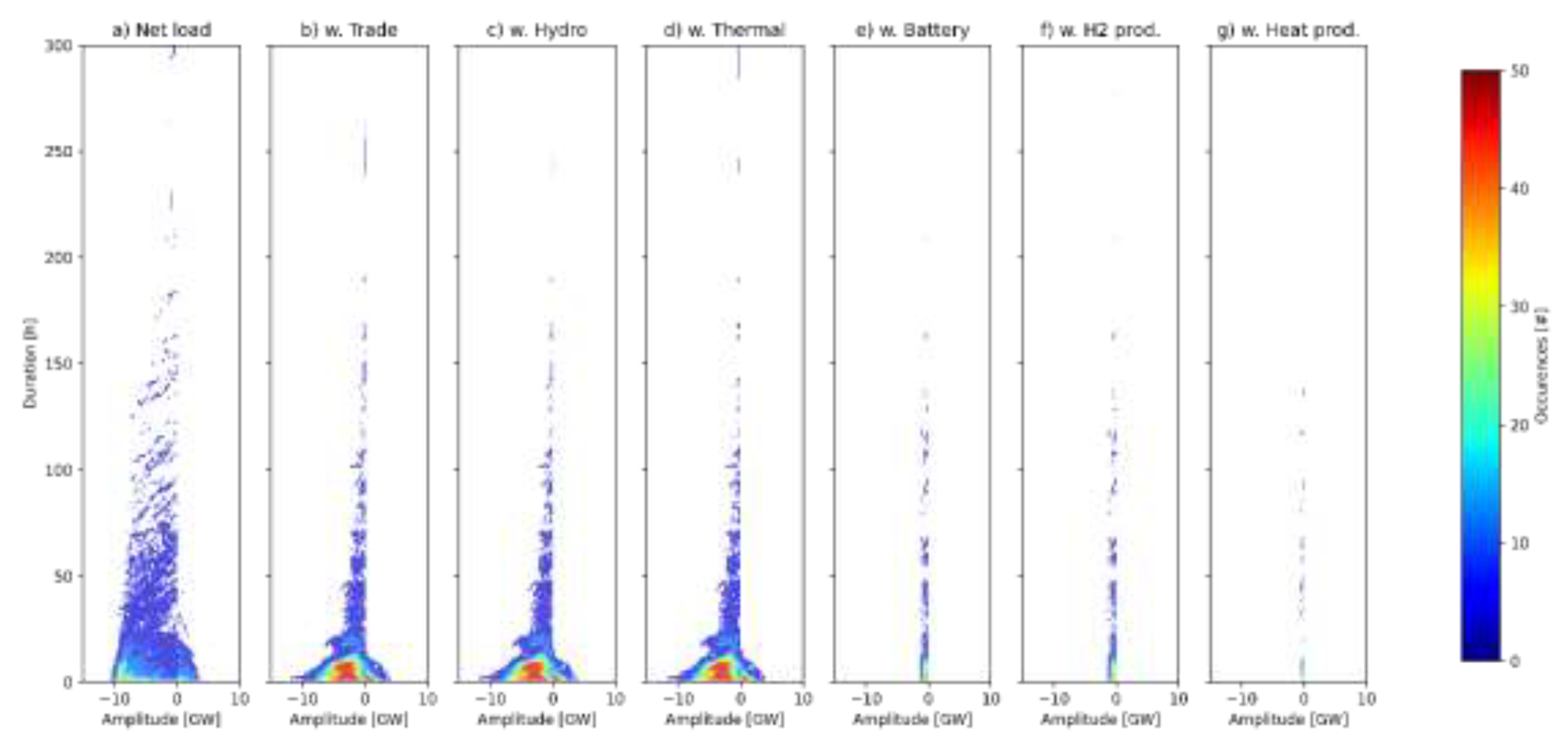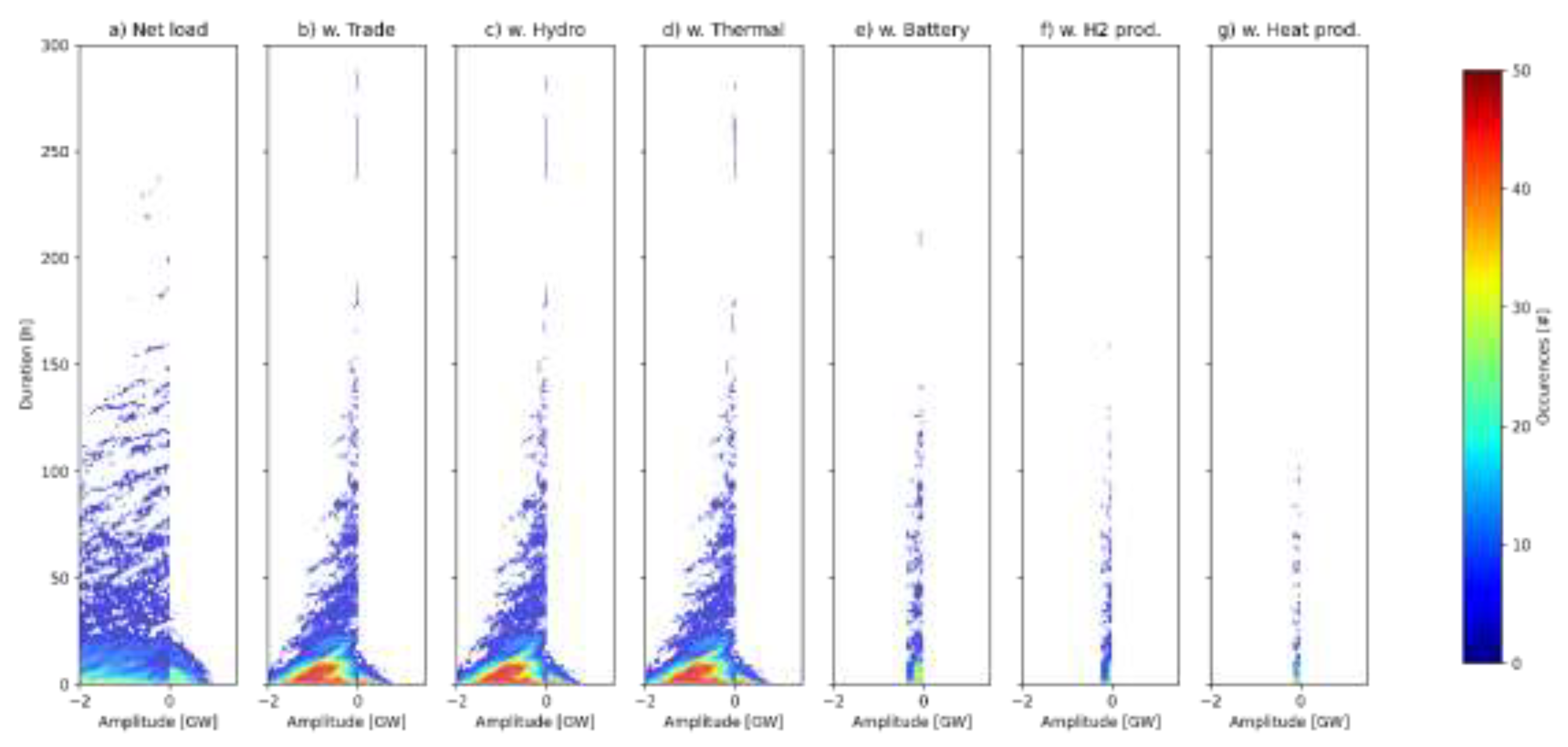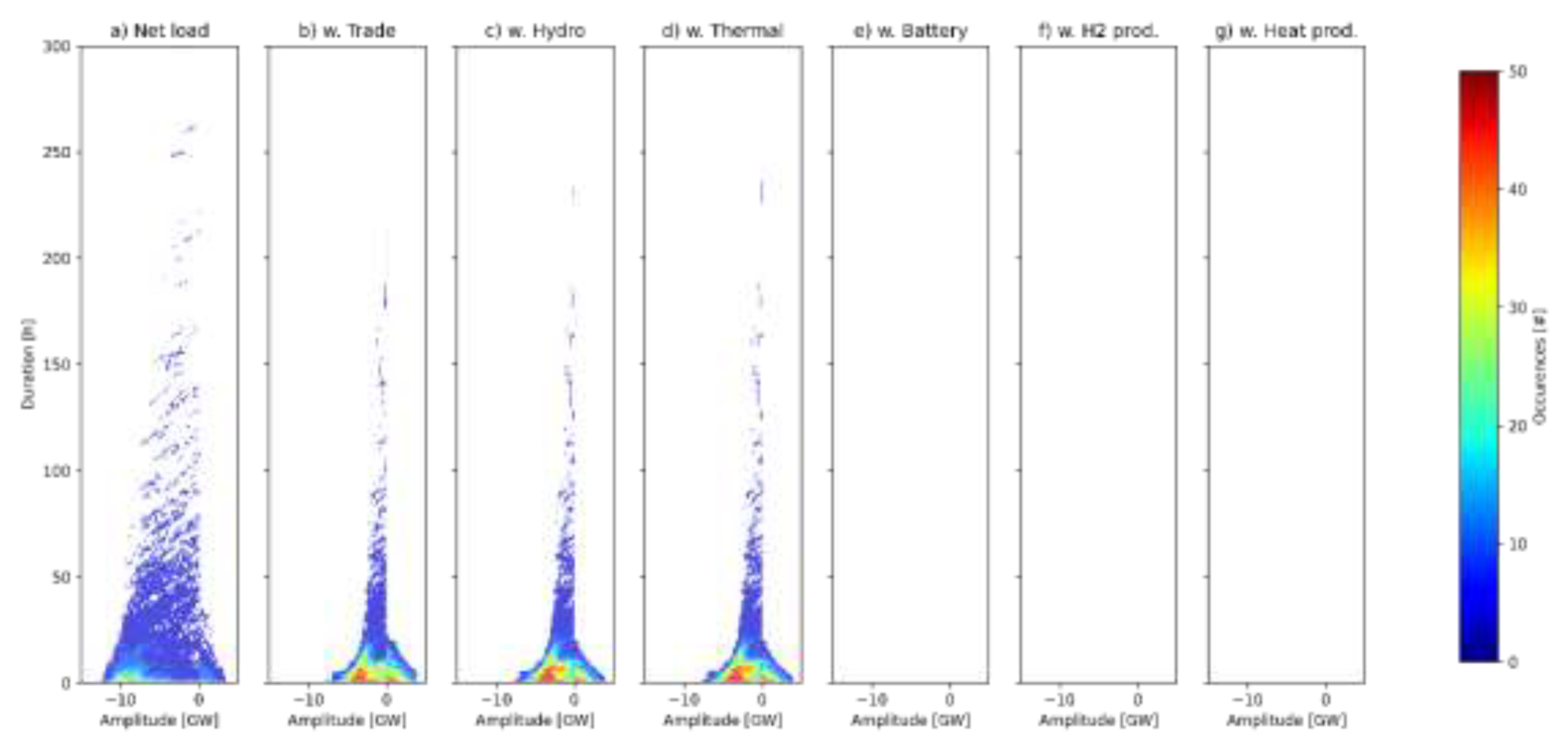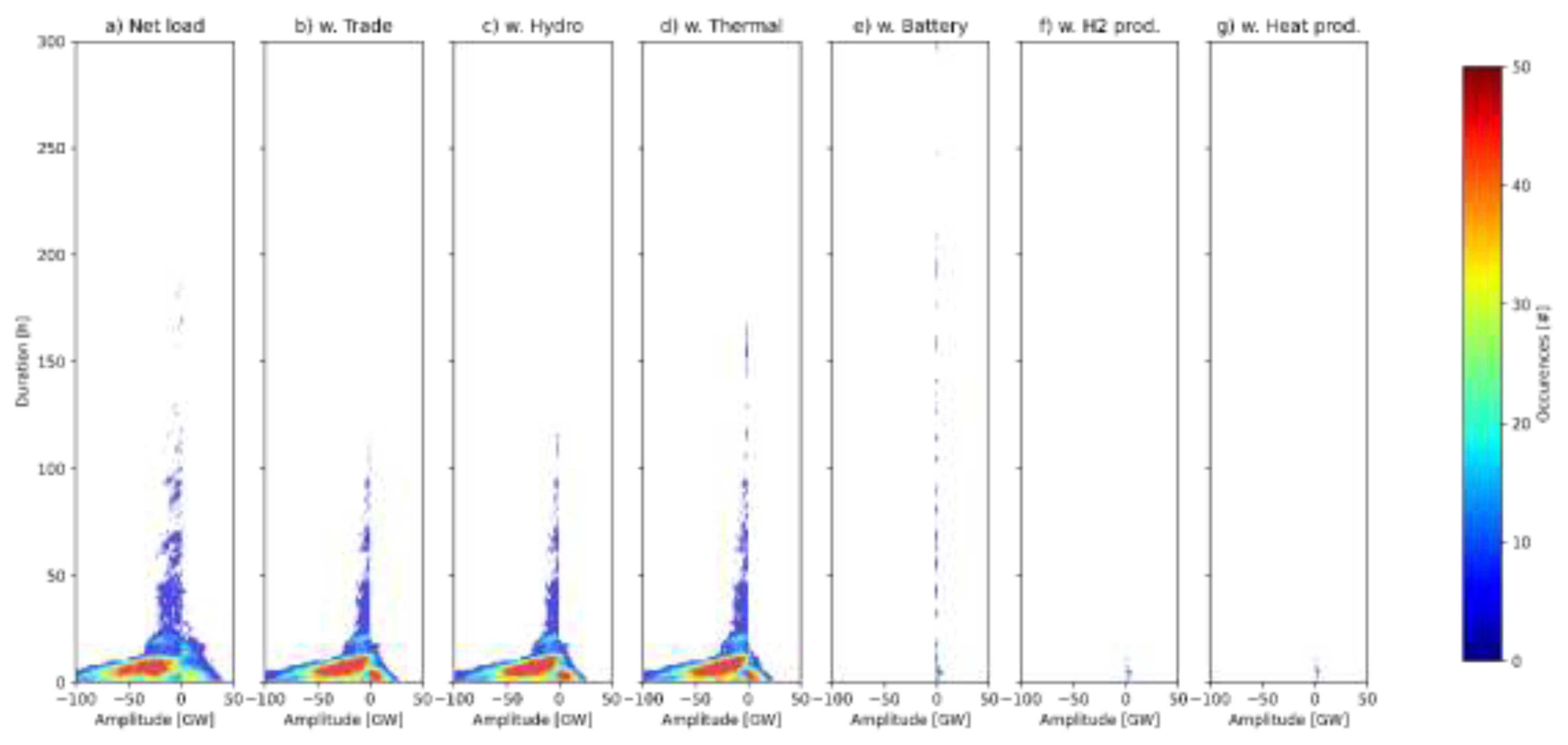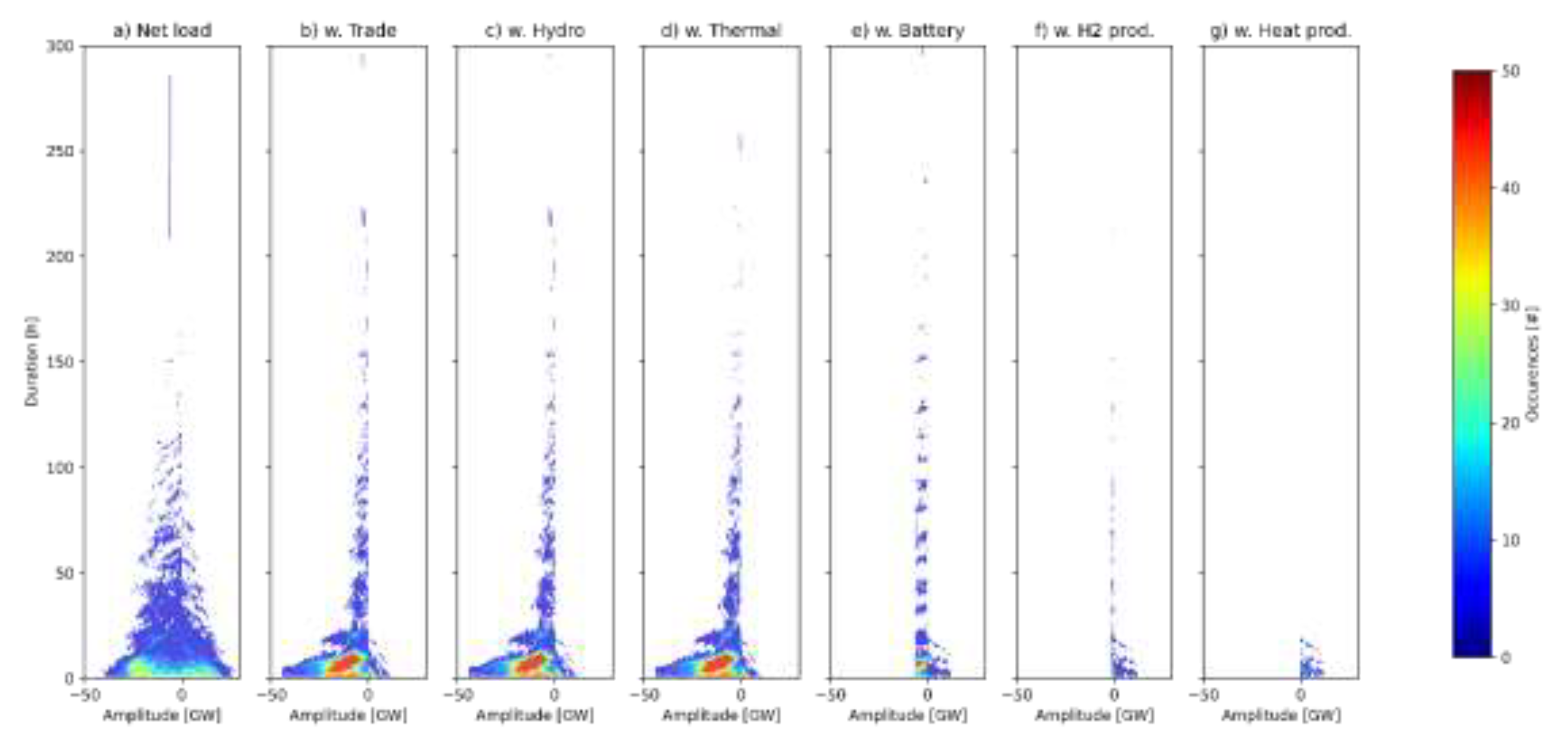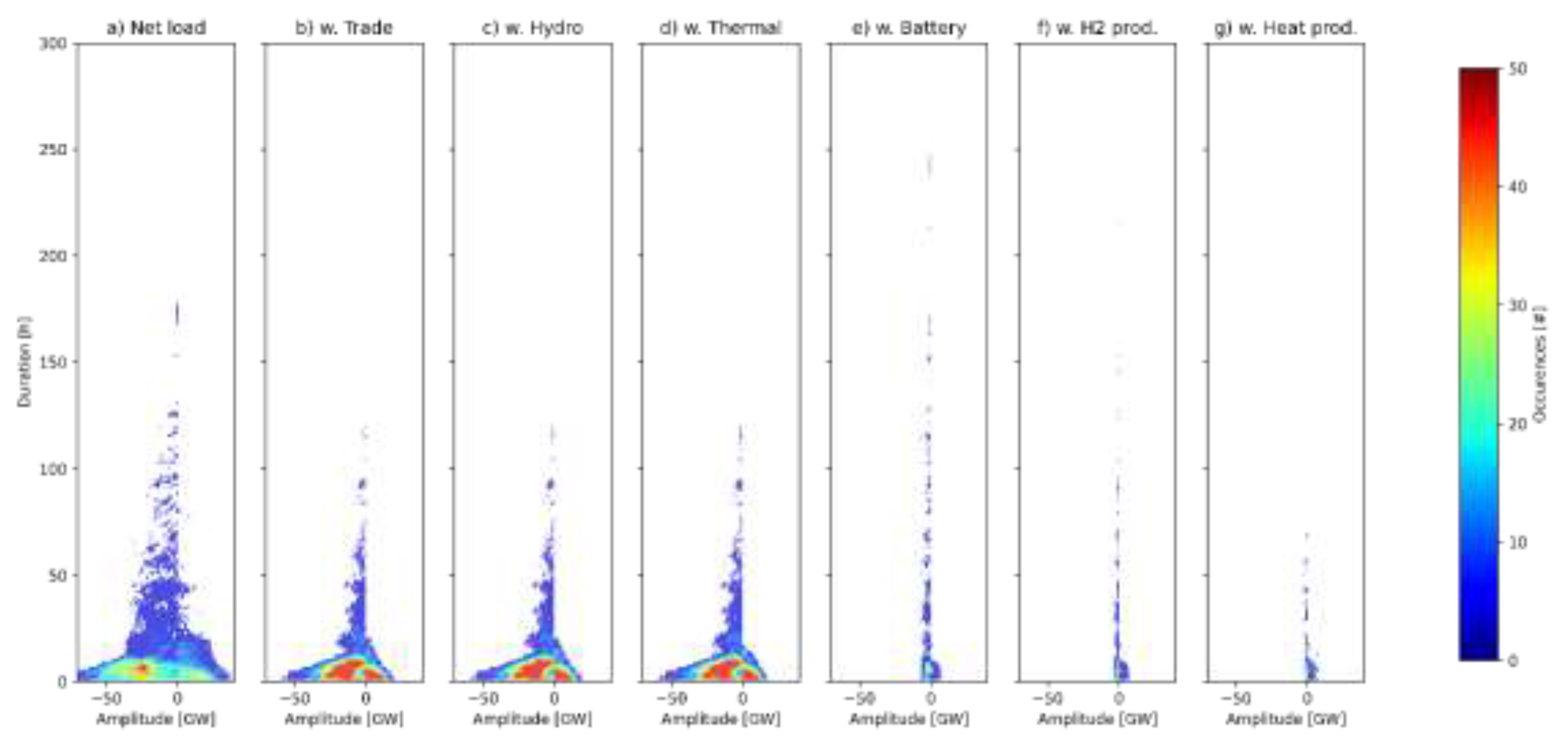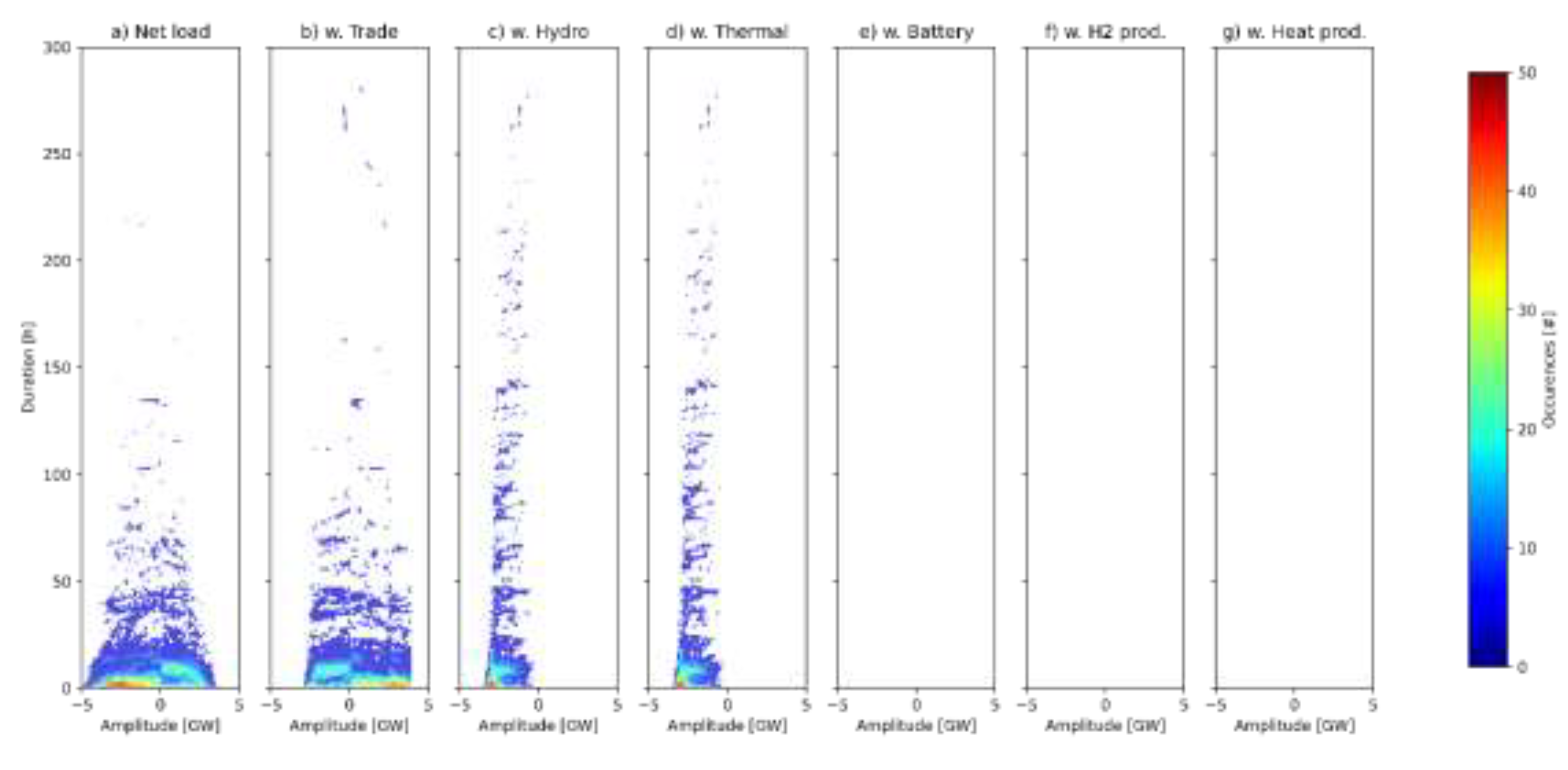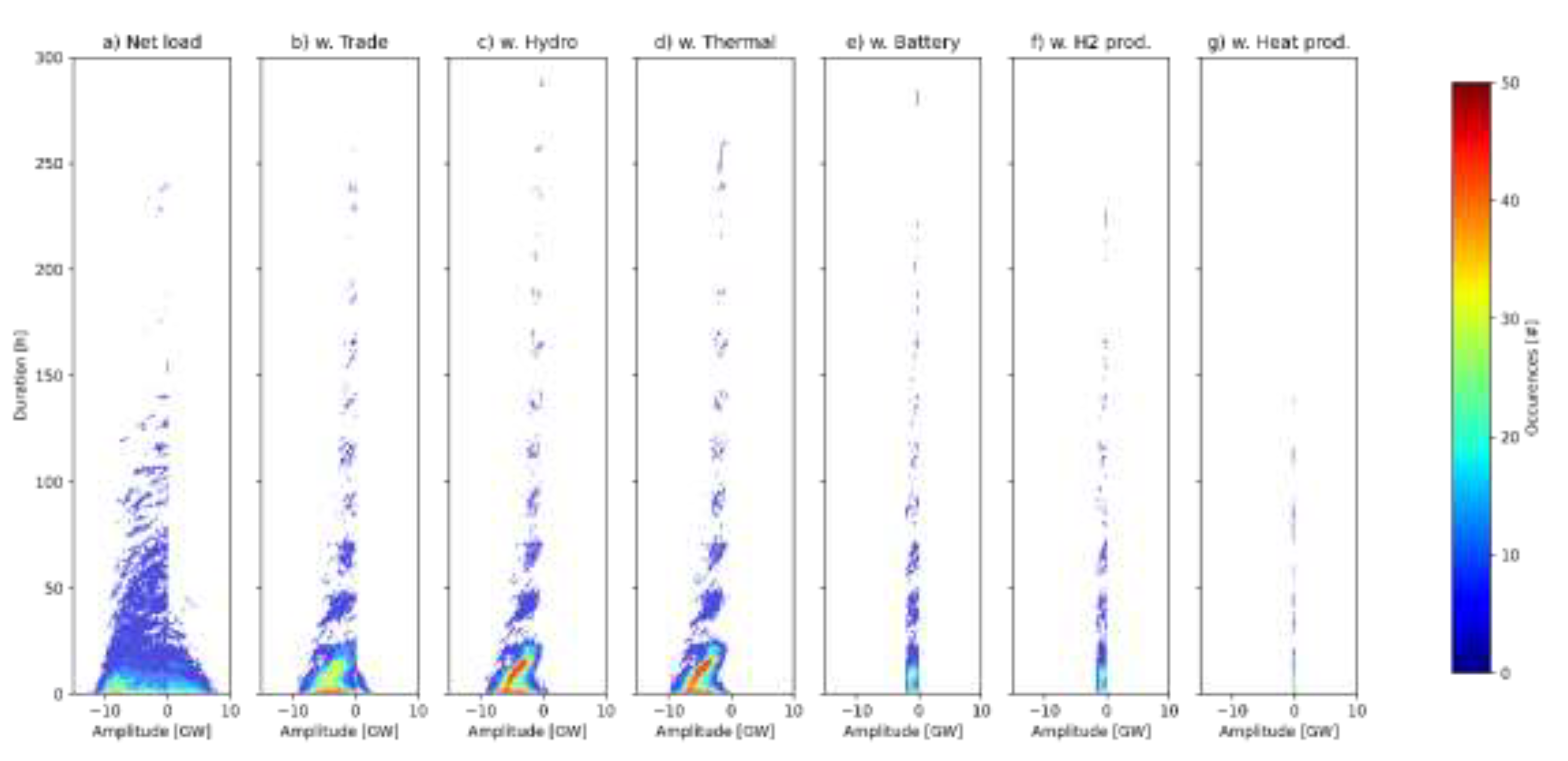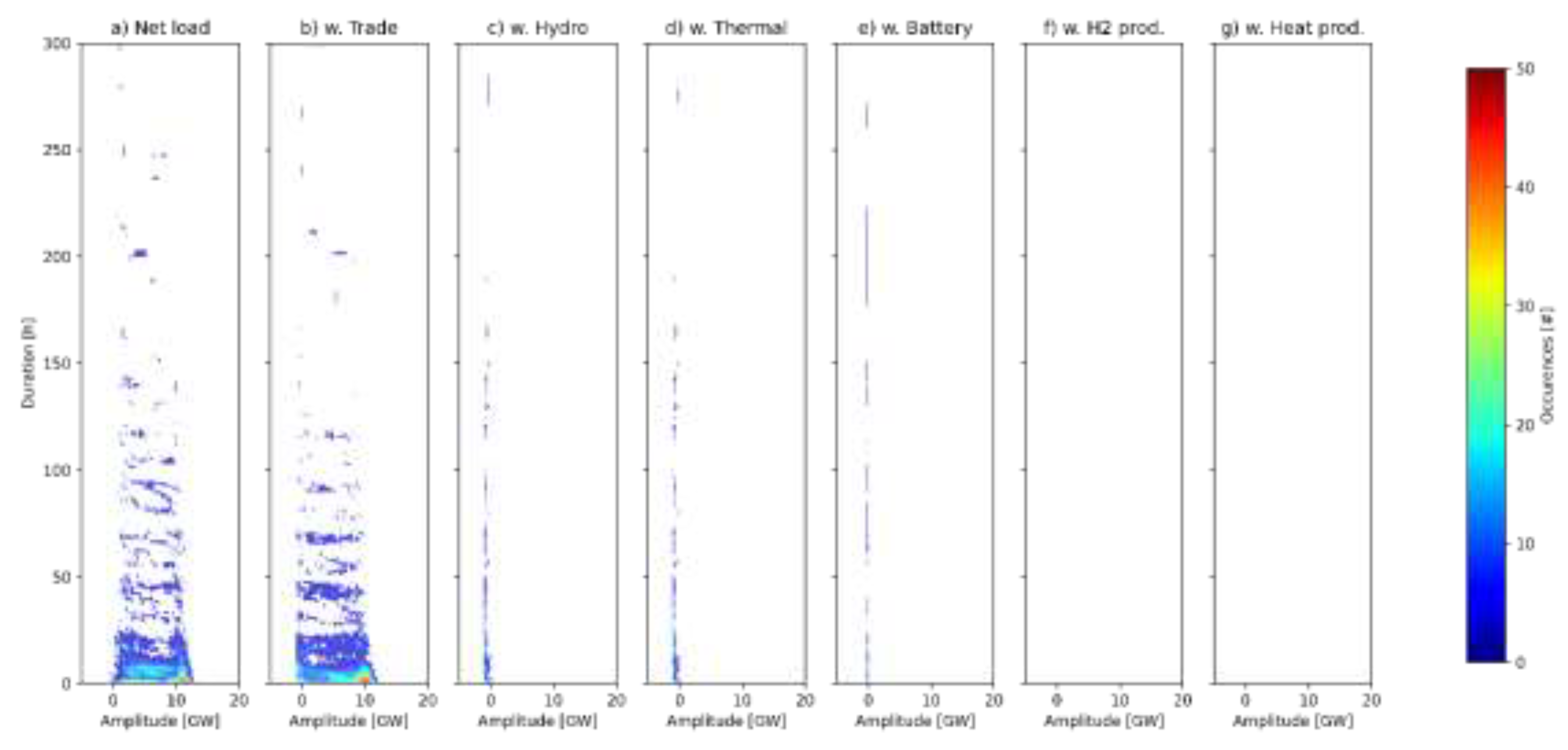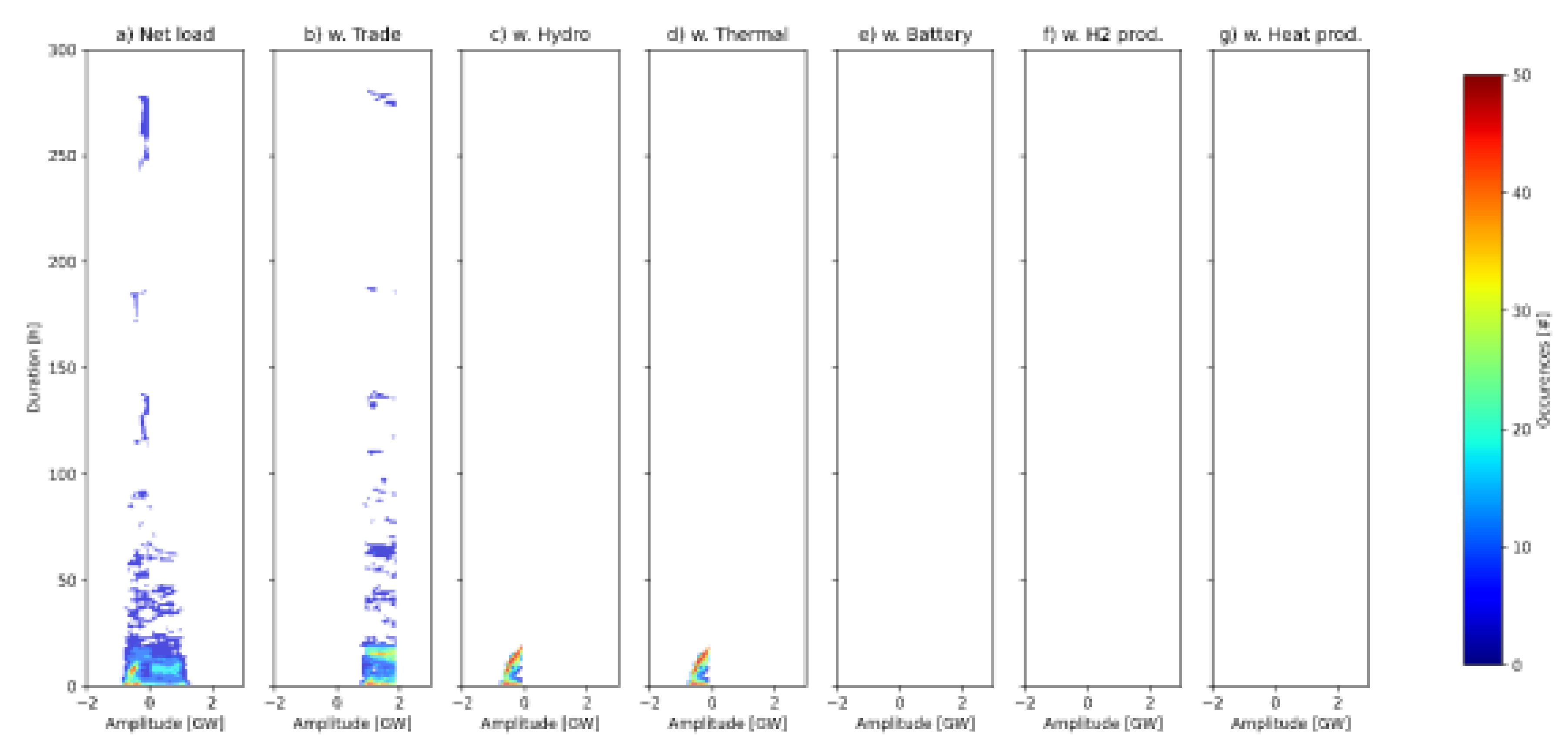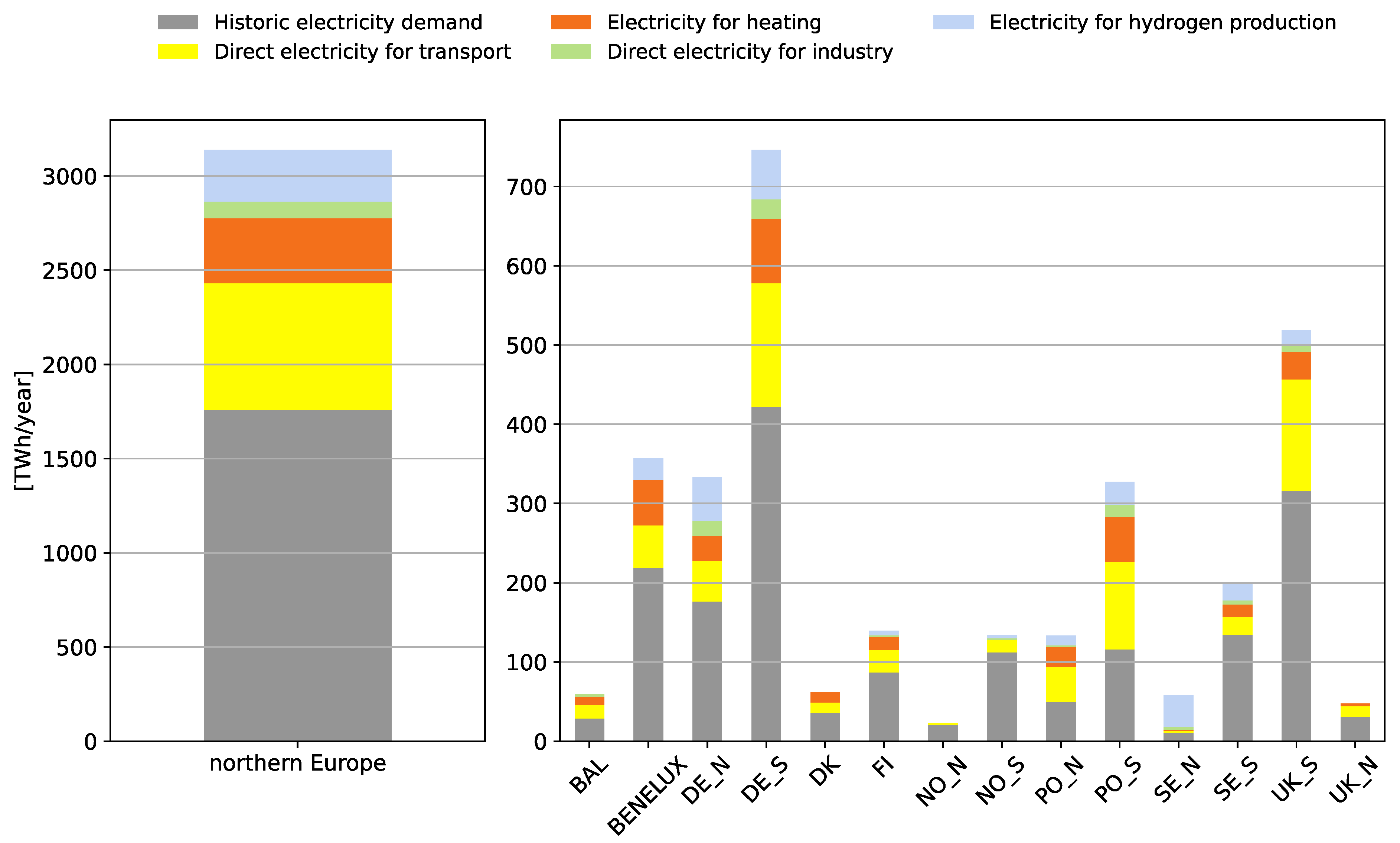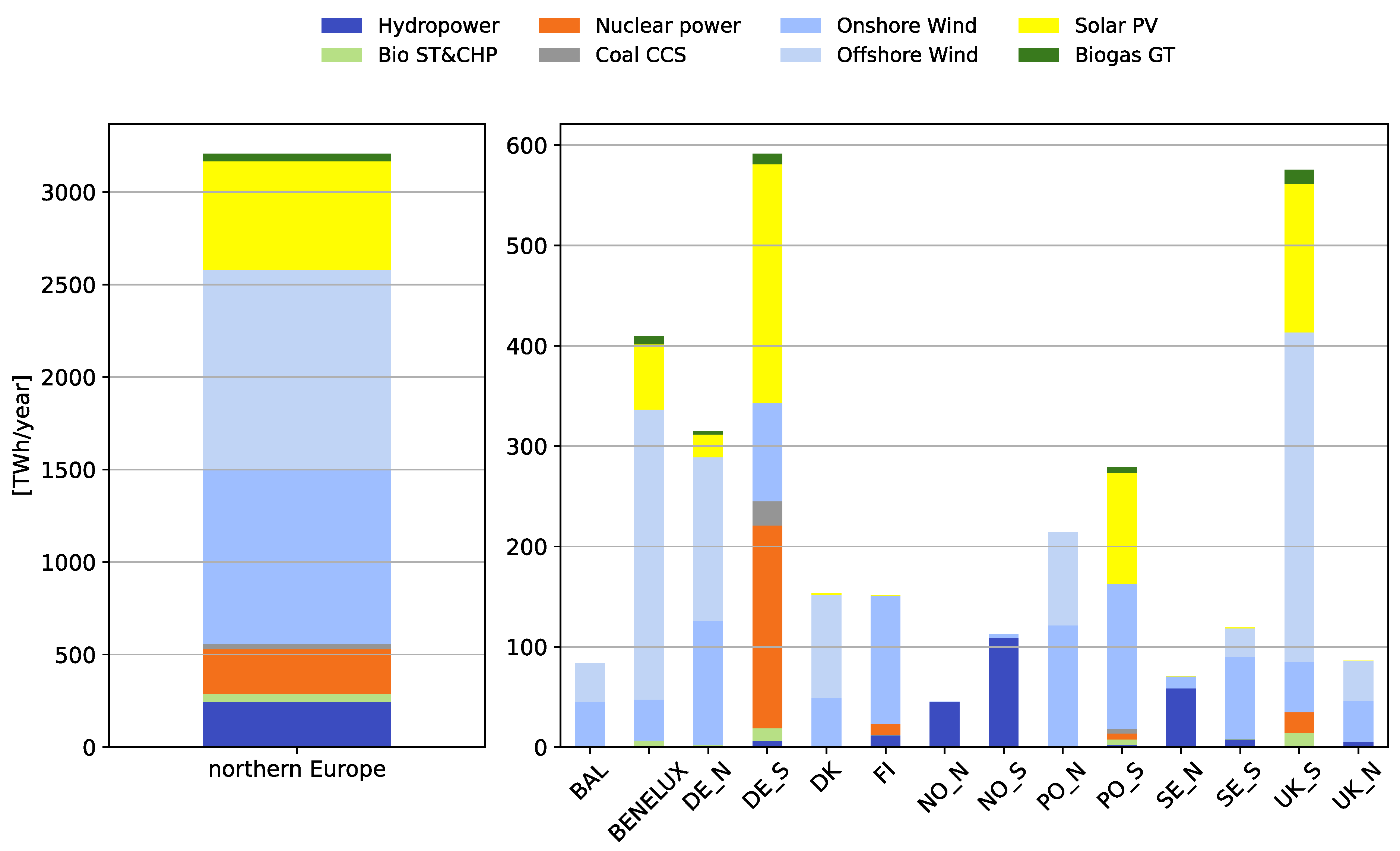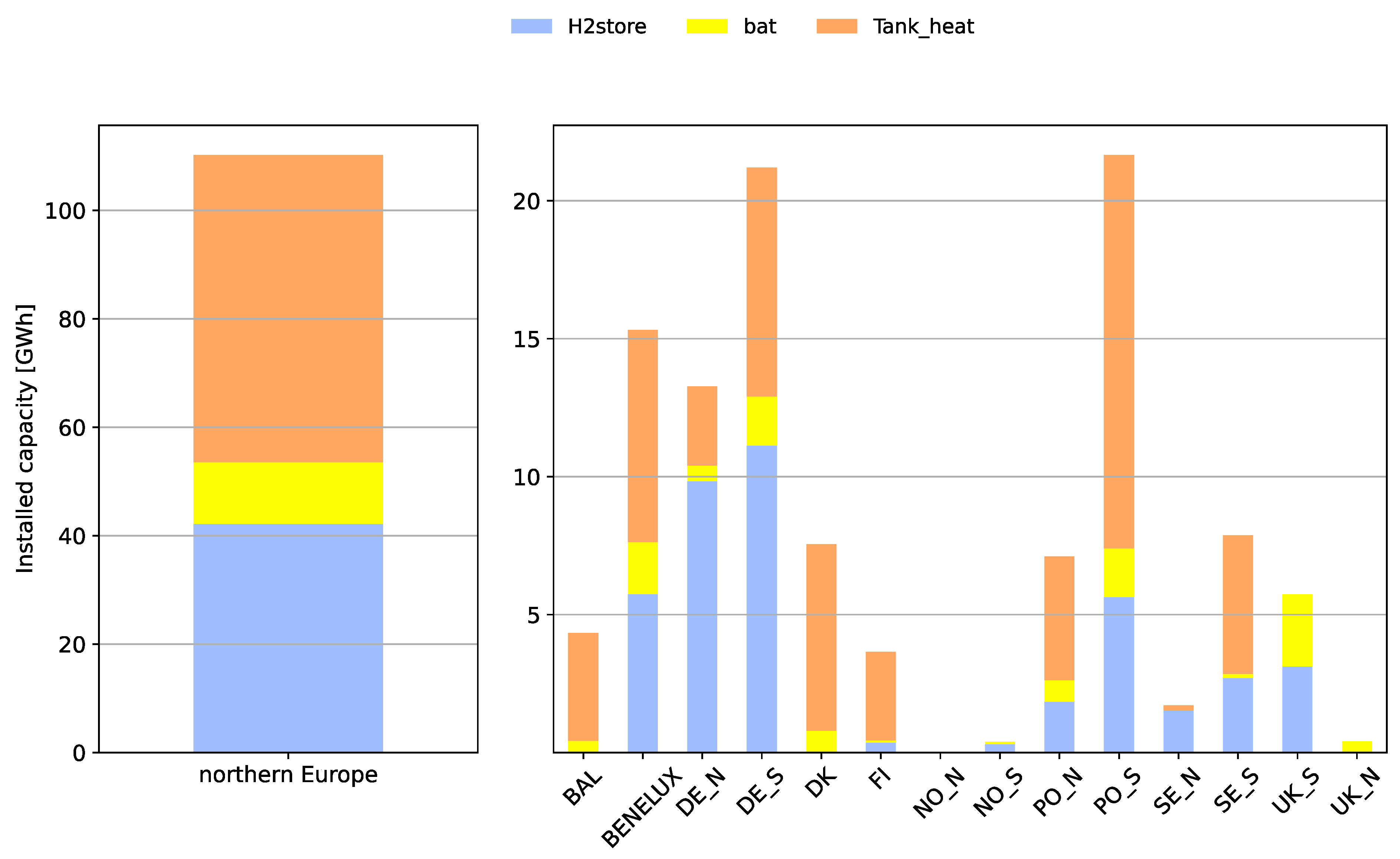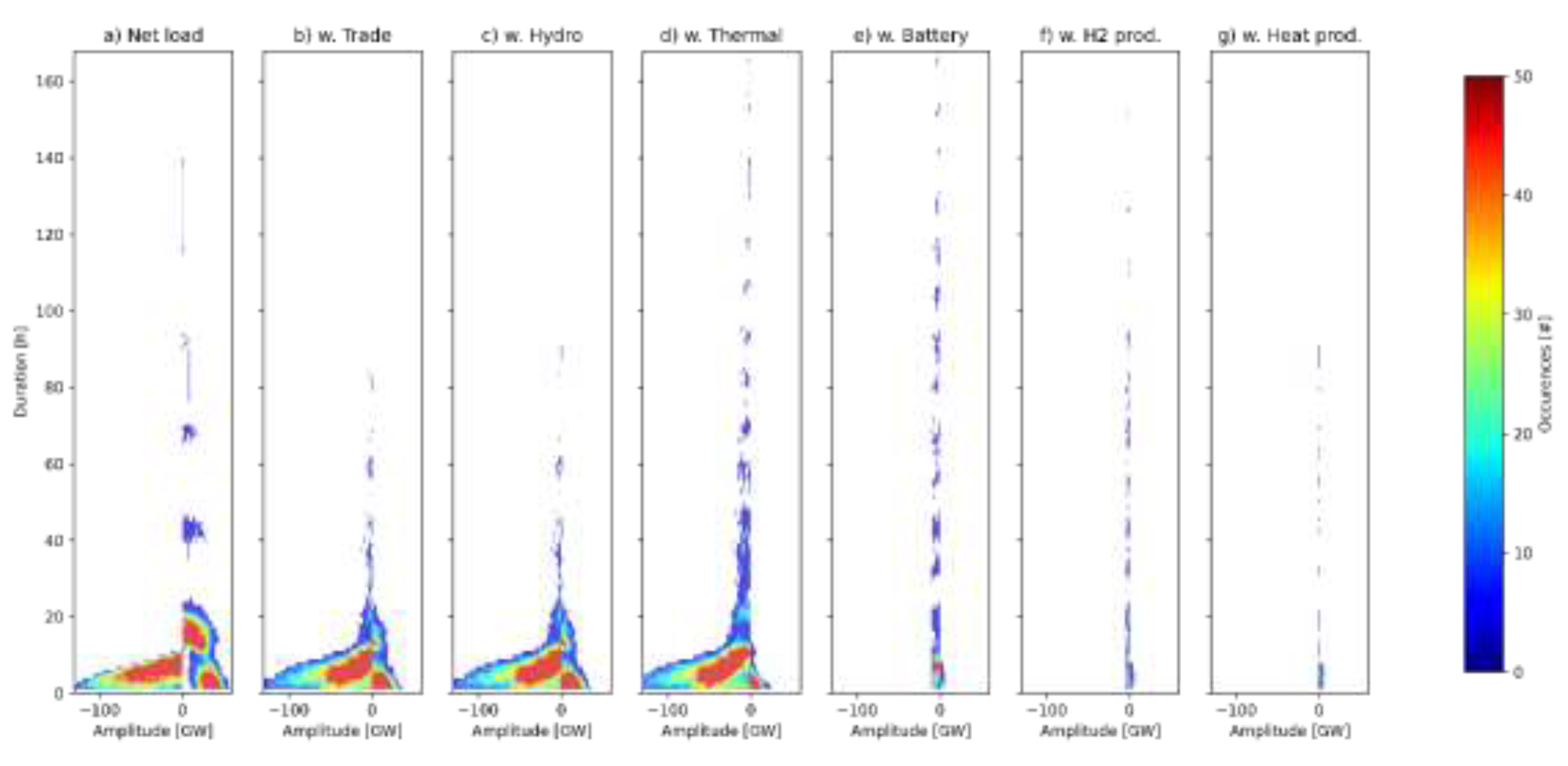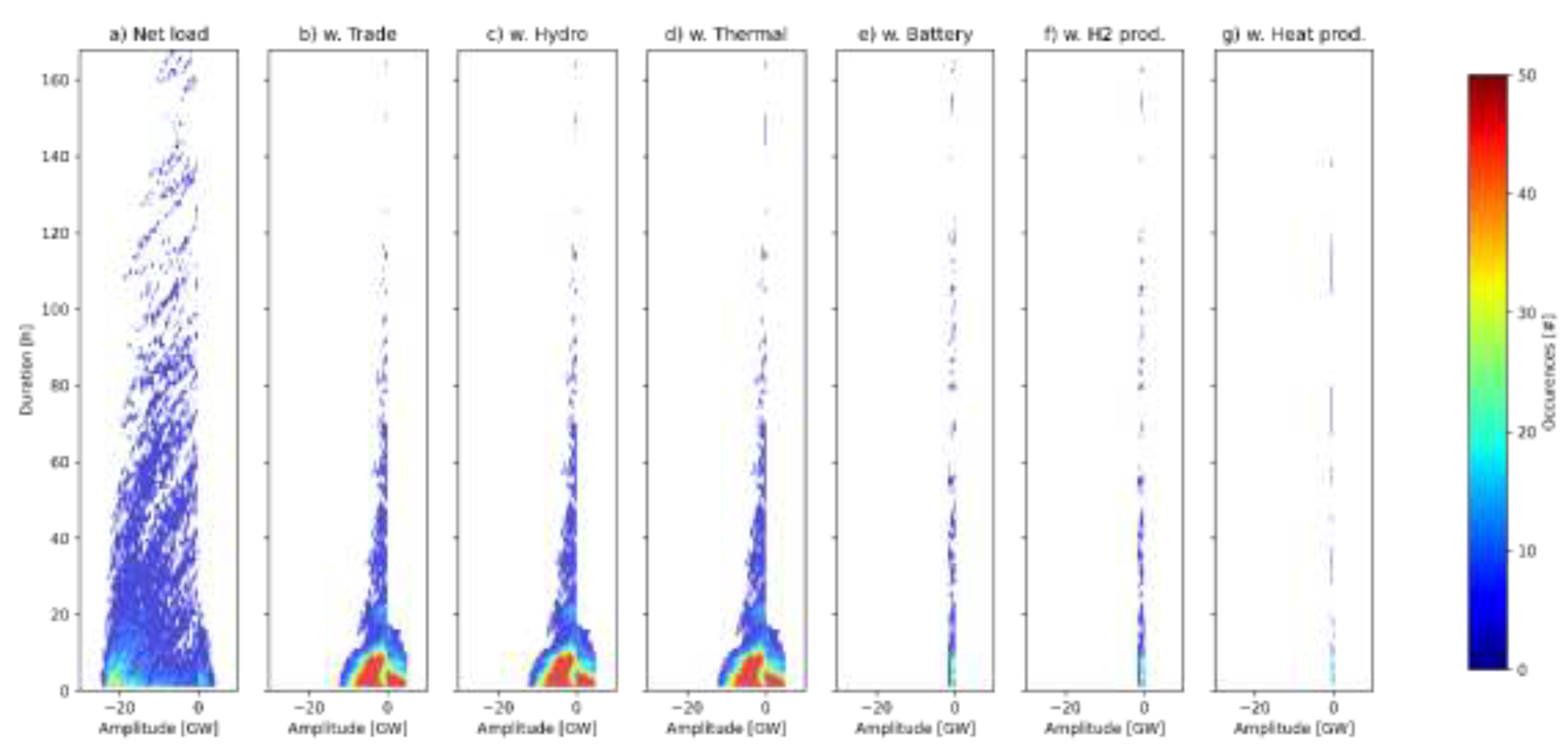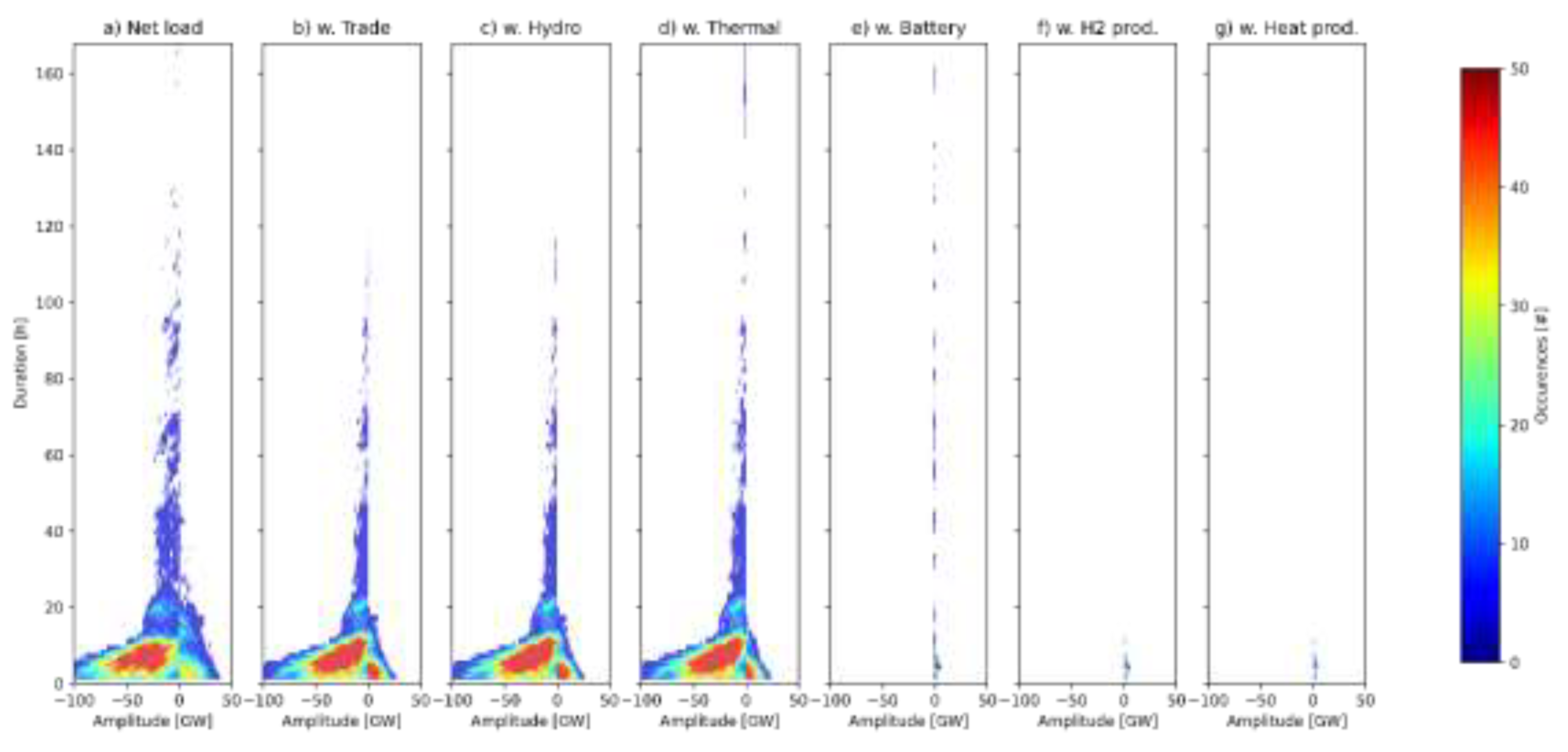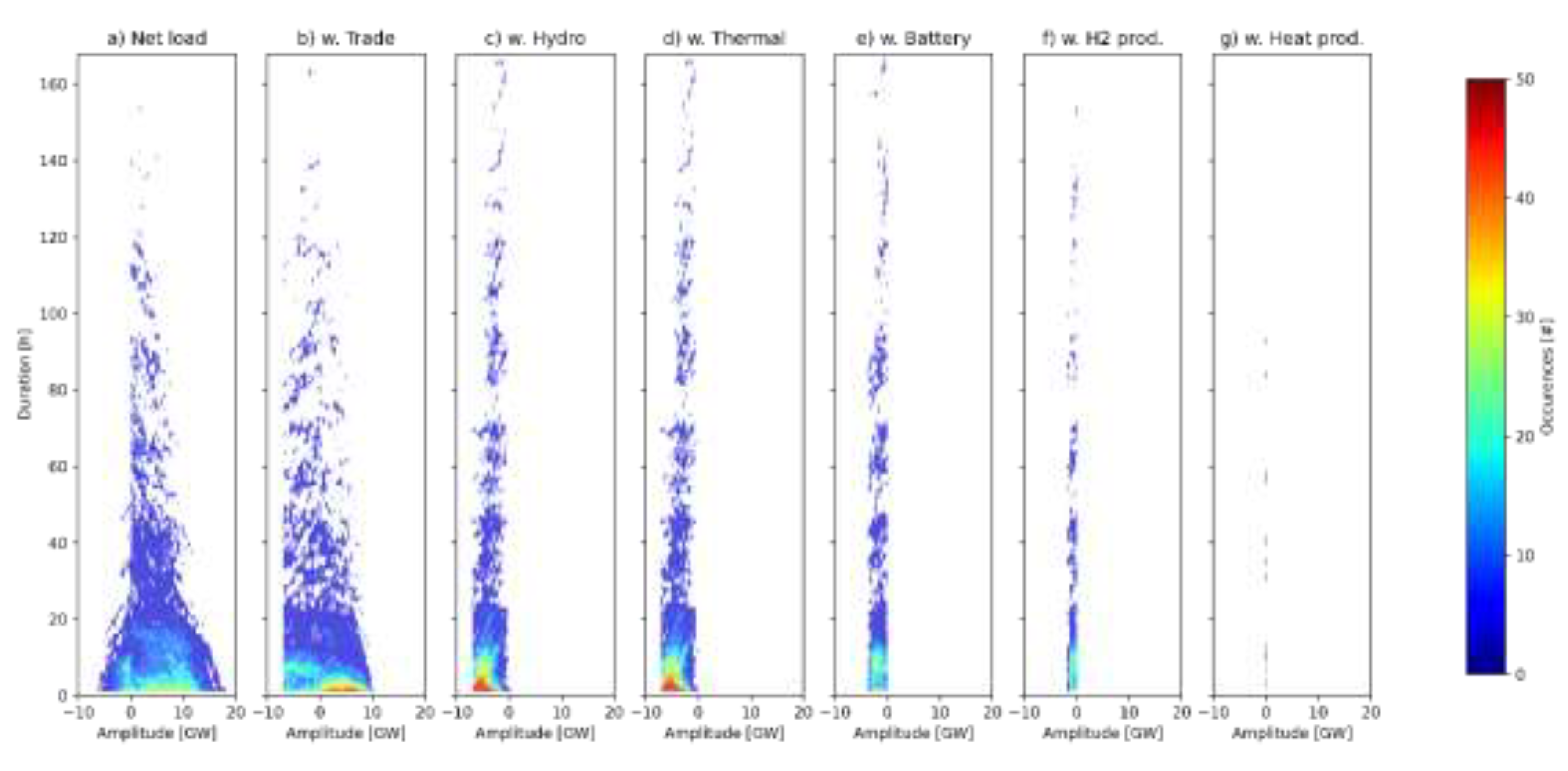1. Introduction
The aim of this work is to visualize how variations in a future north European electricity system can be managed cost-efficiently. The work takes departure in a climate neutral energy system with extensive electrification of the industry, transport and heating sectors. Outlooks for Nordic [
1], north European [
2,
3] and European [
4] electricity systems have been presented in recent years. Common features of these outlooks are a substantial increase in electricity demand which to a large extent is supplied by wind and solar power. Given the varying generation of wind and solar power the ability of the electricity system to manage these variations have become a question of high priority [
5].
There exists a wide range of technologies and strategies to provide flexibility, ranging from shifting the electricity demand for heat pumps in time in single-family dwellings by exploiting the thermal inertia of buildings, to using large-scale underground storages for hydrogen produced for industrial applications. Lund, Lindgren [
6] have conducted a comprehensive overview of different approaches for increasing energy system flexibility. Flexibility measures serve two main purposes, to assure the reliability or increase the cost-efficiency of a given electricity system. This work concerns the latter subset, i.e. flexibility measures with the purpose to manage variability such that the social cost of electricity is reduced. This subset is referred to as variation management strategies (VMS) [
7,
8]. The potential of flexibility measures to reduce the social cost of meeting the demand for electricity is well documented. Previous work investigating the impact of flexibility measures on the operation of a given electricity system report reduced costs as a consequence of reduced curtailment [
7,
9] and reduced operation of peak generation units in favor of varying renewable electricity (VRE) and base load generation [
10]. Studies on the impact of flexibility measures on the cost optimal system composition report reduced costs from increased investments in varying renewable electricity while investments in more expensive electricity generation options are reduced [
8,
11]. Johansson et al. [
8] investigate the impact of a range of variation management strategies on the cost-optimal system composition of electricity systems with different preconditions for VRE. It is found that different strategies influence investments made in and the operation of the electricity system in different ways. In addition, it is found that the cost-optimal investments in variation management strategies depends on the preconditions for VRE generation. These findings indicate that there are different types of variability which need to be matched with the most cost-efficient strategies for each type. It is reasonable to assume that all types of variations are present in all electricity systems, albeit to different degrees, and what we look for is a balanced combination of strategies adequate to the given electricity system.
Few outlooks for the north European electricity system address in detail how variations in the electricity system can be met cost-efficiently. Pursiheimo and Kiviluoma [
3] analyze electrification scenarios for northern Europe with a focus on Finland. The model applied, Backbone [
12] is an investment model with a high time resolution and consequentially with the ability to balance options to manage variations cost-efficiently. Variation management is addressed by illustrating the dispatch of one winter week and one summer week for the Finnish electricity system. Illustrations of the dispatch of electricity systems provide a detailed understanding of how the demand for electricity is met every hour, including how variations are managed, when plotted for a limited time span such as a couple of weeks. However, in order to give an overview of how variations are managed more generally across one or several years other options for visualization are needed. There exists a number of efforts to measure and graphically represent flexibility provision in the electricity system. IEA [
13] propose a flexibility assessment tool (FAST) to estimate if there is sufficient flexibility in a given electricity system to accommodate additional wind and solar power, accounting for flexibility on the demand- and supply-side as well as storage and interconnection capacity. Yasuda, Carlini [
14] introduce flexibility charts which map capacity of flexible generation and interconnections relative to peak capacity of a given electricity system. The tools by IEA and Yasuda rely on easy access statistics to give a first idea of the ability of a given electricity system to manage variations. Using time series from actual or modelled electricity system operation, the contribution of each flexibility supplier can be assessed in more detail. Heggarty, Bourmaud [
15] introduce two graphical tools, the flexibility solution modulation stacks and the flexibility solution contribution distribution, to visualize the contribution of flexibility suppliers on annual, weekly and daily time-scale.
This paper adds to previous outlooks on future north European electricity systems by focusing on how variations in the electricity system is managed using a novel approach of visualizing the net load variability and the contribution of different strategies to reduce this net load. A cost-efficient combination of strategies to manage the net load is derived using a cost-minimizing electricity system model with high temporal resolution representing 11 strategies to manage variations on the demand-side, the generation side as well as pure storage technologies. The contribution of each strategy is visualized using a novel graphical representation in the space spanned by the amplitude, duration, and recurrence of variations. Based on the results, the functionality of different strategies to manage variations can be generalized and connected to a functionality-based framework of strategies to manage variations which facilitate the choice of strategy for a given electricity system context.
2. Method
In order to find cost-efficient strategies of meeting the demand for electricity, heat and hydrogen in a carbon neutral northern Europe the cost-minimizing electricity system model ENODE is applied. Given a time resolved demand for electricity, heat and hydrogen together with costs and technical limitations, ENODE generates investments in and operation of technologies for generating and storing electricity, heat and hydrogen. From these results, net loads (i.e. electricity demand which cannot be moved in time reduced by wind and solar power generation) for each region with and without accounting for strategies to manage variations are produced to visualize the role of each strategy in a carbon neutral northern Europe.
2.1 Electricity System Investment Model
Cost-efficient deployment of variation management strategies is in this work identified using the cost-minimizing electricity system investment model ENODE. The objective of the ENODE model is to minimize the cost of investments and operation of electricity generation and storage capacity, while meeting a given demand for electricity, heat and electricity-based hydrogen. The ENODE model was first presented in [
16] and further developed in [
8] and [
17] to include more options to manage variations and to better represent the heat sector. The model has a high temporal resolution and a detailed technology description, while the temporal scope is limited to 1-2 years. As such, the model results provide a good understanding of the interplay between electricity generation technologies and variation management strategies on the timescale of hours to seasons. In this work, the model is run with a 3-hour time resolution for two years (with investment costs represented as annualized costs) representing year 2050 in terms of technology costs and carbon emission limitation, i.e. only technologies without net carbon dioxide emissions are included as investment options. Existing hydropower is assumed to remain in place together with the new nuclear power in Finland and the nuclear power under construction in the UK.
In this work, the ENODE model is applied to northern Europe subdivided into 14 regions as given by the map in
Appendix A. The demand for electricity, heat and hydrogen has to be met in each region every timestep. Electricity can be traded between regions. The existing transmission grid is assumed to remain in place and additional investments in transmission capacity of up to 5 GW per connection is allowed.
On the supply side, nine technology options are included including thermal base load generation such as nuclear power, biomass-based combined heat and power and bio-blended coal with carbon capture and storage as well as thermal peak generation in terms of biogas open-cycle and combined-cycle gas turbines. A total list of technologies together with their cost properties are given in
Appendix B. On- and offshore wind power and solar PV is represented using time resolved wind and solar power production potential for the regions investigated. The prower production potential is derived using [
18] which rely on ECMWF ERA5 [
19] and the Global Wind Atlas [
20] for historical years 1991-1992. These two years were chosen since they represent one year with lower hydropower inflow in the Nordic countries (1991) and one year with higher hydropower inflow in the Nordic countries (1992). The potential for wind and solar PV investments per region together with their respective full load hours are given in
Appendix B. Electricity demand corresponding to temperature variations in historical years 1991-1992 is also derived using [
18].
This work investigates a future north European electricity system assuming a carbon neutral energy system which is targeted to be attained by the European union around 2050 [
4]. By 2050, it is expected that we have already experienced a significant increase in temperature due to global warming [
9]. Thus, in this work we assume an increase in global mean temperature of 2 degrees. In northern Europe a warmer climate is expected to mainly impact the energy system through changed hydropower inflow, reduced demand for heating and increased number of incidents induced by extreme weather [
21]. In this work we account for the two former factors based on [
22] which show and increased annual average hydropower production distributed more evenly across the year in the Nordic countries together with reduced demand for district heating and electricity for heating purposes in wintertime.
In this work, an electrification of the transport sector and the industry sector is assumed together with a shift from natural gas for heating purposes to individual heat pumps in Germany, the Netherlands, Poland and the UK. The electricity demand for heating of single family dwellings is calculated according to Nyholm [
23], accounting for energy efficiency improvements. In addition, there is a heat demand corresponding to the demand for district heating in the regions investigated [
24]. The heat demand can be met by heat only boilers, but also combined heat and power plants (CHP), heat pumps and electric boilers. The inclusion of thermal energy storage enables a temporal decoupling between heat production and electricity production/consumption and facilitates a strategic heat production which offer flexibility to the electricity system.
The electrification of industry includes electrification of steel, cement and ammonia. The total production of steel, cement and ammonia in the regions investigated is assumed to remain at today’s levels. In cement production, plasma burners are assumed for high temperature heating with a continuous demand for electricity over time. There is an exogenously given demand for electricity-based hydrogen (i.e. hydrogen produced from electricity) corresponding to the electricity demand from the steel industry and the ammonia industry . The hydrogen demand is a simplified representation of an electrification of industry and is distributed evenly across all hours of the year, assuming a continuous operation of industrial processes. By overinvesting in electrolyser capacity and hydrogen storage a strategic hydrogen production, which offers flexibility to the electricity system, can be achieved.
A full electrification of the road transport is assumed. The majority of vehicles are assumed to charge as they are parked. However, 30 % of the cars charge flexibly in time and can also discharge back to the grid. Vehicle charging is implemented as described by Taljegard [
25]. It should be noted that also these cars are constrained to meet the demand for transportation as defined by the vehicle movement data collected by Kullingsjö and Karlsson [
26].
Furthermore, the model includes the option to invest in stationary batteries to manage variations as well as fuel cells to regenerate electricity stored as hydrogen. Thus, the strategies to manage variations included in this work encompass supply-side, demand-side and pure storage options.
Table 1 list the strategies to manage variations included in this work together with the technologies they involve.
2.2 Visualizing the Net Load
The method suggested in this work takes departure in the proposition that variability can be defined by its amplitude, duration and number of occurrences. With number of occurrences we here refer to how often variations with certain amplitude and duration takes place. According to time series analysis, any time series in a linear system can be described in two dimensions: amplitude ad frequency. Weather systems, controlling wind speeds and thus the net load in electricity systems supplied to a large extent by wind power, are however composed by a combination of linear and non-linear phenomenon. For this reason we find it practical to subdivide the frequency into duration and number of occurrences and we will refer to the three dimensional space spanned by the amplitude, duration and number of occurrences as the variation space.
Algorithm 1 describes how to map the net load of any electricity system into the variation space in 6 steps. The resulting plot illustrates to which extent the net load variations to be managed are variations of high amplitude, long duration or high occurrence or any combination of these. We refer to the map of the net load in the variation space as the variation profile of the electricity system. An overview of the variation profile is a first step to identifying cost-efficient strategies to manage the net load variations.
In order to understand the role of different strategies to manage variations in an existing electricity system, or a future system proposed by electricity system models, the remaining net load after the strategy is applied is calculated and plotted. By comparing the original variability profile and the variability profile after a strategy has been applied it is possible to identify to which extent the strategy reduces variations of high amplitude, long duration or high number of occurrences.
Algorithm 1. Creating the variability profile.
| ALGORITHM 1 CREATING THE VARIABILITY PROFILE |
| 1: |
. |
| 2: |
Define a list where the step length is small enough to give a high resolution of the amplitude in the plots. We here use = 0.1 GW |
| 3: |
for negative net loads).
:
|
| 4: |
Find the end of each variation interval and get the duration
For :
For
if
else if
|
| 5: |
for a certain combination of duration and amplitude
:
|
| 6: |
Plot occurrences of variations with amplitude on the x-axis, duration on the y-axis and occurrences on the z-axis. |
| |
|
3. Results
Figure 1 gives the annual electricity demand for the regions investigated. The historic electricity demand (grey) represents the electricity demand prior electrification. The direct electricity demand for transport (yellow), and industry (green) and electricity for hydrogen production (blue) are a consequence of the assumptions and input data presented in the method section. The electricity demand for heating (orange) corresponds to electricity for individual heat pumps replacing natural gas, which is given exogenously, but also electricity demand for district heating, which can be met by combined heat and power plants and heat-only boilers as well as heat pumps and electric boilers. The total electricity demand for heating is thus a result of the optimization. For the case investigated the increase in electricity demand from electrification corresponds to an increase in the annual electricity demand of around 80 % in northern Europe. As illustrated in
Figure 1, the electricity demand as a consequence of electrification of transport is increased in particular in the regions with a high population density such as south Germany (DE_S), south Poland (PO_S) and south UK (UK_S). The electricity for hydrogen production is located to regions with extensive industry (Sweden, Germany, Poland, the BENELUX region and the UK).
Figure 2 gives the annual electricity production in the regions investigated as a result of the electricity system model presented in the method section. Applying the costs presented in the Appendix it is found to be cost-efficienct to meet 2/3 of the annual electricity demand in northern Europe with wind power (blue). As illustrated in
Figure 2, there are two major clusters of offshore wind power in northern Europe, one off the coast of northern Germany, the Netherlands and Denmark and one off the coast of the UK. With very good conditions for wind power but limited electricity intensive industry, Denmark is the single largest exporter of electricity (DK exports 90 TWh/year). The opposite is true for south Germany which imports 165 TWh/year for the case investigated. Solar PV supply 1/5 of the electricity demand in northern Europe and is mainly located to the southmost regions (south Germany and south Poland) from which other regions import solar PV. South UK also have large solar PV investments to complement wind power since import capacity from continental Europe is limited.
Figure 3 gives the installed capacity of energy storage for the regions investigated. Total energy storage capacity in northern Europe corresponds to 11 TWh for the case investigated. The volume of energy storage capacity reflects the investment cost of energy storage capacity. Tank heat storages are the cheapest energy storage option but is only relevant in regions with district heating (district heating is very limited in Norway and the UK). Hydrogen storage is the second cheapest option for energy storage, relevant to regions with a demand for hydrogen. Batteries are significantly more expensive and battery investments are mainly located to regions with substantial electricity supply from solar PV. To investigate the role of energy storage in the different regions and how electricity demand and supply is balanced every hour, four regions with different conditions for wind and solar power and different access to flexibility measures are further investigated.
Figures 4a–7a gives the variation profile for DE_S, DK, UK_S and SE_S as defined in the method section. These four regions represent four different types of regions observed in modelled northern Europe; regions with extensive solar PV capacity (DE_S and PO_S), regions with extensive wind power for domestic use and export (DK, BAL, PO_N and UK_N), regions with a combination of wind and solar power (UK_S, BENELUX and DE_N) and regions with access to hydropower (SE_S, SE_N, FI, NO_N and NO_S). The color scale is cut at 50 occurrences, implying that the number of occurrences may be higher in the deep red fields. The y-axis is cut at 168 hours, one week. Some variations of longer duration occur and plots with a y-axis of 300 hours for all regions are given in
Appendix C.
As the Figures 4a–7a shows, netload variations are very different between the regions investigated. Netload variations in Denmark (
Figure 5a), with a supply-side dominated by wind power, have variations with low amplitude and number of occurrences but long duration. This is contrasted by net load variations of south Germany (
Figure 4a), dominated by solar PV, with netload variations of high amplitude and number of occurrences but few variations of long duration. The pattern of the variations in solar dominated Germany represents the nature of solar PV with high occurrence in positive net load at a duration of 12-15h corresponding to night, high occurrence in positive net load with high amplitude and a duration of a few hours corresponding to afternoon peaks and high occurrence of negative net load with a duration of 2-10 hours and varying amplitude corresponding to daytime solar PV production. Variations of longer duration reoccur with 24h intervals and correspond to cloudy days. The variation profile of south UK (UK_S) is a combination of the variation profile of south Germany and Denmark, with the typical pattern of solar PV variations, but with lower amplitudes and occurrences than those in south Germany due to lower total installed capacity, but also positive and negative variations of longer duration which are characteristic for wind power. The variation profile of south Sweden (SE_S) resembles the one of Denmark, indicating a wind dominated net load. However, the net load is oriented towards positive amplitudes corresponding to a need for additional generation capacity to complement the wind power in order to meet the load.
Figure 4,
Figure 5,
Figure 6 and
Figure 7 illustrate how strategies to manage variations reduce the net load variability in the four example regions. The 11 strategies in
Table 1 are here aggregated into 6 groups of strategies to facilitate an overview. Thermal here includes all thermal electricity generation except open-cycle gas turbines (Adapted biogas combined-cycle electricity production, Adapted biomass combined heat and power production, Adapted biomass electricity production, Adapted nuclear power production). Based on the electricity generation supplied by different sources (see
Figure 2), nuclear power dominate this group of strategies. Batteries include stationary batteries and charging of electric vehicles since previous work shows that these strategies act on the same time scales in the electricity system [
2]. This implies that we add a load, which is fixed to 70 % and flexible to 30 % according to assumptions, together with the charging and discharging of stationary batteries. Finally, Heat here includes both heat production with heat pumps and electric boilers connected to the district heating system (Adapted heat production and Opportunistic heat production in
Table 1). However, this group mainly represents variation management by heat pumps since electric boilers play a very minor role in all regions investigated.
Figure 4b–g gives the net load reduced by six different strategies for southern Germany. Electricity is imported to solar PV dominated south Germany, reducing positive nighttime net load. The positive net load is further reduced by base load generation (
Figure 4d). At the same time, base load generation increase negative net load of long duration. Due to the limited flexibility of nuclear power, production is not only added when needed but also during hours of low net load. The negative net load of long duration caused by base load generation is reduced by strategic production of hydrogen and heat (
Figure 4f–g). However, in the solar PV dominated south Germany, the strategy with the largest impact on the net load is batteries (
Figure 4e). Stationary batteries match the charging of electric vehicles (in this work 70 % of the vehicle charging is fixed in time) to the solar PV generation and thereby reduce the net load variations. Batteries have a relatively low cost of charging and discharging power and high efficiency which makes the well suited for the solar PV variations with high amplitude and occurrence. In general, it can be observed that investments in stationary batteries are particularly substantial in regions with a large demand for electricity for transport (cf.
Figure 1 and
Figure 3) and that solar PV generation is large in the same regions (
Figure 2). The net load variations of low amplitude, duration and occurrence which remain in
Figure 4f is supplied by biogas open-cycle gas turbines.
Figure 5b–g gives the net load reduced gradually by the six strategies to manage variations in Denmark. Denmark has some of the best conditions for offshore wind power in northern Europe and together with its central location between the Nordic countries and continental Europe it becomes an ideal exporter of electricity. The majority of this electricity is exported to northern Germany and onwards to load centers in southern Germany. The extensive export is reflected in the strong reduction of the wind dominated net load variations by trade. Trade with Germany also introduce solar variations in Denmark, as seen in
Figure 5b. These variations are efficiently reduced by batteries. Remaining net load variations have low amplitude but sometimes long duration. These variations are in Denmark primarily reduced by heat pumps in the district heating system (
Figure 5g).
Figure 6b–f gives the net load reduced by strategies to manage variations in south UK. The system composition is here a combination of wind and solar power, as illustrated in
Figure 2, and the netload has both variations of long duration and variations of high amplitude and occurrence. It is important to note that by combining wind and solar power in the electricity mix, net load variations have to some extent been reduced already from the start. In particular, solar PV production reduce the duration of low wind events and wind power reduce positive nighttime netload of solar power. These complementary effects are visual by comparing the net load in
Figure 6a to those in Figures 4a and 5a. Trade, primarily with northern UK, further reduce net load variations of around 20-24 hour duration. However, it is by combining wind and solar power together with the use of batteries for variations of high amplitude and occurrence that the majority of the variations in this region is managed. Some variations of low duration and high recurrence are managed by strategic production of hydrogen. The net load which remains in
Figure 5f is managed by biogas open-cycle gas turbines.
Figure 7b–f illustrates how the net load is reduce by five different strategies to manage variations in south Sweden.
Figure 7b gives the net load reduced by trade (northern Sweden excepted). As the figure shows, trade shifts the net load to the left indicating that south Sweden imports electricity. However, since it is mainly imports from Denmark which is wind dominated like south Sweden, the variability of the net load curve is similar after accounting for trade. Some solar variations of high recurrence and amplitude but short duration are introduced with the trade.
Figure 7c gives the netload reduced by trade and hydropower, including trade with northern Sweden. Even though electricity demand in northern Sweden is increased substantially, hydropower from the north is exported to south Sweden during low wind events since the demand in the north is predominantly made up by electricity for hydrogen production which is avoided during low wind events. As the figure shows, positive net load is reduced drastically by hydropower and hydropower manage positive net load of any duration. Batteries and the charging of electric vehicles reduce the amplitude of the remaining, negative, net load (
Figure 4e). The remaining net load is of low amplitude and any duration which is managed by strategic production of hydrogen (
Figure 4f) and heat (
Figure 4g). With a high cost of electricity consumption capacity (electrolyser and heat pump) but a low cost of energy storage (underground hydrogen storage and storage of hot water) variations of low amplitude but long duration match the cost structure of the strategies. It is important to note that the strategic production of heat and hydrogen does not only consume “excess” electricity, but the presence of these flexible electricity demands stimulate investments in wind power production while avoiding consumption during low wind events, thus increasing the supply of wind power during all hours of the year and facilitating to meet the net load also during low wind events. The little remaining net load visible in
Figure 7f is met by open cycle gas turbines.
4. Categorizing the Cost-Efficient Contribution of Variation Management Strategies
The results confirm that different variation management strategies contribute with different functionality in the electricity system. At the same time, the contribution from each strategy, in terms of reduction in net load amplitude and recurrence on different timescales, is qualitatively similar in the four regions investigated. However, the size of the investments in different strategies and their quantitative contribution is different in the three different system contexts.
As the objective of the model applied in this work is to minimize the total cost of the electricity system, the investment and operation of the variation management strategies as given in this work is cost-efficient given the options available. That is, the functionality provided is motivated by the cost structure and technical limitations of each strategy. High reductions in the amplitude of recurring variations are cost-efficiently supplied by strategies with low cost of charging and/or discharging power, such as batteries. In order to manage variations over longer timescales, a low cost of energy storage is required. In the examples given in this work, the cost of hydrogen storage represents the cost of storing hydrogen in large-scale underground caverns, which is low compared to energy storage in batteries. The cost of storing fuel for thermal generation is omitted in the model, which allows combined-cycle gas turbines and combined heat and power plants to manage variations of long duration. Variations with low recurrence is most efficient to manage with strategies with low investment cost, such as open-cycle gas turbines. The low recurrence admits a high running cost.
The roles identified by the measures can form the basis for a functionality-based categorization of strategies to manage variations. Whereas previous categorizations of strategies to manage variations are based on the technical properties of the strategies, a categorization supporting the understanding of the functionality of the strategies to manage variations in the electricity system should rely on cost-structure. Based on the above reasoning and the work by [
7,
8] the following categories are proposed:
Peaking strategies, which manage variations of low recurrence. Similar to peak production plants, peaking variation management strategies have low investment cost in terms of charging, discharging and storage capacity. However, the low investment cost is typically accompanied by a high operational cost, i.e. a high cost of electricity discharged or low value of electricity charged.
Shifting strategies, which reduce recurring variability on shorter timescales. These strategies are associated with a low cost of charging and discharging capacity and a low cost of operation, since variability on shorter timescales have high amplitude and high recurrence. However, a low cost of charging and discharging capacity is typically associated with a high cost or a limited capacity to store energy. Thus, these strategies are mainly applied for shifting loads or production during shorter time intervals.
Complementing strategies, which manage recurring variations on longer timescales. These strategies are associated with a low cost of energy storage. However, since the amplitude of variations on longer timescales is lower, a higher cost associated with the charging and discharging power is admitted. A low to medium cost of operation is required from these strategies since variations managed are of long duration and medium recurrence. This category could be further subdivided to differentiate between complementing strategies managing variations on weekly and seasonal timescale.
A categorization based on cost-structure has the advantage that the category reveals the functionality of the strategy. This categorization thus facilitates the choice of variation management strategies for different system services and contexts.
5. Discussion and Limitations
In this work, net load variations are plotted in the space spanned by amplitude, duration and occurrence (i.e. the variation space) to better understand how different strategies to manage variations complement each other. For this analysis, the cost-efficient combination of a large set of strategies provided by the electricity system investment model is required. However, plotting a gradually reduced net load in the variation space can also be useful to understand how variations are managed in an existing system, using electricity production data.
Applying the method proposed to map the contribution of flexibility measures to reduce the net load, functionality-based categories of variation management strategies can be identified. The vast majority of previous categorizations have focused on the technical properties of the flexibility measures. For example, Fuchs, Lunz [
27] and Zhao, Wu [
28] subdivided electricity storage systems into electrical, mechanical, chemical and thermal storage units, while Sauer [
29] differentiated between electricity-to-electricity storage, electricity-to-anything storage and anything-to-electricity storage systems. Palizban and Kauhaniemi [
30] have mapped energy storage systems with respect to those applications for which they are suitable and unsuitable, using a color-coded matrix. Other categorizations have focused on the motive for the investment, such as single-use/double-use [
31] which distinguishing between investments that are actively made and are dedicated to providing flexibility (single-use) for the electricity system and those cases in which assets that are already integrated in the electricity system for other purposes are used (double-use). While all of these categorizations support the understanding of flexibility measures, measures with the same functionality in the electricity system are distributed between categories in the above-mentioned frameworks. Previous work by the author [
7] propose instead a functionality-based framework, organizing variation management strategies according to the service they provide in the electricity system. This work further develops this framework.
The strategies applied in the regions modeled in this work are cost-efficient from an energy-only perspective. However, without the perfect foresight of the modelled world, flexibility markets may be needed to stimulate investments prior large electricity price variations. In the design of flexibility markets, a market for each of the above-mentioned categories would assure competition between strategies providing the same function to the electricity system and stimulate investments in a balanced set of strategies. The size of the different markets should be defined by the electricity system context, i.e. the need for the different functionalities based on the variability profile of the present and coming electricity systems.
This work investigates strategies to manage variations on the time-scale of hours to a couple of years. Variations within the hour as well as variations with very low occurrence (e.g. once every ten or thirty years) is outside the scope of this work. Meng, Zafar [
32] provide an overview on how variations on very short time-scales, to recover the frequency after faults, can be managed in electricity systems with high share of wind and solar power. They conclude that batteries with grid-forming converters, with the ability to provide active power very fast, are able to replace synchronous generators with maintained ability to recover the frequency after a fault. However, if synchronous generators can be replaced completely remains to be investigated. Ullmark [
33] show that if batteries are allowed to meet the demand for variations within the hour these variations can be managed to a low cost (<1% of total system cost).
Ruhnau and Qvist [
34] investigate the impact of variations in the German electricity system over a 30-year period and find that there are low wind events of long duration (60 days with short periods of interruption) which occur very seldom. As shown in this work, the choice of strategy for a certain type of variations depends on cost-structure. Variations with long duration and low occurrence are cost-efficiently managed by strategies with low cost of storage and low investment cost. A cost-efficient strategy to manage the variations identified by [
34] would thus be biogas gas-turbines with sufficiently large storage of biogas. Sufficient biogas turbine capacity is likely to already be available to the electricity system to manage variations with shorter duration occurring on a yearly basis. The fuel costs during the 60 days period would be significant but, since these events occur very seldom, have low impact on the total system cost and the overall electricity system composition.
6. Conclusions
In this work a novel tool of mapping variations in the electricity system is applied to visualize how variations can be managed cost-efficiently in a future northern Europe. Results show that cost-efficient variation management depends on system context. More specifically it depends on the nature of the variations present in the electricity system as well as the context specific prerequisites for variation management, such as extensive demand for hydrogen from industry, availability of district heating grids or access to hydropower.
Electricity systems with good conditions for solar power and extensive electricity demand for transportation are subject to variations of high amplitude and recurrence which can be managed cost-efficiently using batteries with low cost of charging and discharging power and low losses per cycle. Examples of such regions in northern Europe are south Germany and south Poland, with an inland location and high population density. In these regions there may also be room for some base load generation.
Electricity systems with good conditions for wind power, such as Demark, the Netherlands and northern Germany, manage variations through trade, including import of solar PV, and strategic production of hydrogen and/or heat. Extensive industrial hydrogen demand or district heating systems facilitate the integration of wind power since wind variations have long duration and hydrogen and heat can be stored to a relatively low cost.
In regions with good conditions for wind power but limited trade, such as the UK, it is cost-efficient to combine wind power capacity with solar PV capacity to reduce the duration of low wind events. Hydropower is often cost-efficient to combine with batteries, where the former manage positive net load of short and long duration but the latter manage variations of high amplitude including negative net load. In general, cost-efficient variation management is achieved by combining wind and solar power, and strategies of different cost structure.
Funding
This research was funded by MISTRA, grant number 70200202 and the Swedish Energy Agency grant number 70200134.
Data Availability Statement
Key data applied in this work are given in the manuscript, in the Appendix or is referenced. Data can be made available on request.
Acknowledgments
The Author would like to thank Viktor Walter and Filip Johnsson for valuable discussions, as well as Tom Brown and Juha Kiviluoma for feedback on early work.
Conflicts of Interest
The author declares no conflict of interest.
Appendix A
Figure A1.
Northern Europe subdivided into 14 regions as applied in this work.
Figure A1.
Northern Europe subdivided into 14 regions as applied in this work.
Appendix B
Table 2 gives the investment costs together with the operation and maintenance costs (O&M) for electricity and heat generation applied in this work. Costs are based on IEA [
35] and the Danish Energy Agency [
36], except for nuclear power and wind power with low specific power (SP). The investment cost for nuclear power have been estimated in dialogue with experts. It corresponds to the average investment cost in case of several units are invested in and is lower compared to levels given for Europe by the IEA. The cost to manage waste (today 4 €/MWh in Sweden) is expressed as a small addition to the variable cost (0.5 €/MWh) to manage fuel waste and a larger fixed cost at manage the plant at the time of decommissioning (corresponding to 3.5 €/MWh after 60 years with 90 % utilization) allocated to fixed O&M. Nuclear is assumed to be able to vary output between 70-100% of rated power. The majority of wind turbines today have a specific power around 300 W/m2. However, turbines of lower specific power (generator capacity over swept rotor area) are advantageous for sites with lower average wind speeds and offshore. Hodel, Göransson [
37] assess cost-efficient turbine designs in different system contexts using a cost model to assess the cost of a range of wind turbine designs. Investment costs for onshore wind turbines with 100 W/m2 and 150 m tower height and for offshore wind turbines with 200 W/m2 and 150 m tower height are based on their work.
Table 3 gives cost and properties of energy storage options. These costs are based on the Danish Energy Agency [
36]. The cost of transmission capacity is assumed to 2k€/MW*km, where the distance is taken as the distance between a point in each region with extensive grid capacity. The calculations apply annualized investment costs which are derived using 5 % interest rate and technical lifetimes as given in Table 2. Table 4 gives the fuel costs applied in this work.
Table A1.
Costs and properties of electricity and heat generation units. CHP=Combined Heat and Power, CCS = Carbon Capture and Storage, CCGT = Combined Cycle Gas Turbine, OCGT = Open Cycle Gas Turbine
Table A1.
Costs and properties of electricity and heat generation units. CHP=Combined Heat and Power, CCS = Carbon Capture and Storage, CCGT = Combined Cycle Gas Turbine, OCGT = Open Cycle Gas Turbine
| Technology |
Investment cost [M€/MW(h)] |
Variabel O&M cost [€/MWh] |
Fix O&M cost [k€/MW,yr] |
Technical lifetime
[yr] |
Efficiency
[%] |
| Biomass steam |
2.0 |
2.1 |
52 |
40 |
35 |
| Biomassa CHP |
3.3 |
2.1 |
105 |
40 |
30 |
| Coal w. CCS1
|
3.5 |
2.1 |
107 |
40 |
40 |
| Biogas CCGT |
0.90 |
0.8 |
17 |
30 |
61 |
Biogas
OCGT |
0.45 |
0.4 |
15 |
30 |
42 |
| Nuclear power |
4.0 |
7.1 |
123 |
60 |
33 |
| Solar PV |
0.3 |
0.5 |
7 |
40 |
100 |
Onshore wind power
(100W/m2 150m ) |
1.65 |
1.1 |
13 |
30 |
100 |
Onshore wind power
(300W/m2 100m) |
1.0 |
1.1 |
13 |
30 |
100 |
Offshore wind power
(200W/m2 150m) |
1.75 |
1.1 |
36 |
30 |
100
|
| Heat pump |
0.9 |
2.2 |
2 |
25 |
3 |
| Electric boiler |
0.1 |
1 |
1 |
20 |
1 |
Table A2.
Costs and properties of storage technologies. Investment costs for batteries (power), electrolysis and fuel cells are given in M€/MW while costs for batteries (energy) hydrogen storage and heat storage are given in M€/MWh.
Table A2.
Costs and properties of storage technologies. Investment costs for batteries (power), electrolysis and fuel cells are given in M€/MW while costs for batteries (energy) hydrogen storage and heat storage are given in M€/MWh.
| |
Investment cost
[M€/ MW(h)] |
Efficency
(ch/disch)
[%] |
Fix O&M cost
[k€/MW(h),yr] |
Technical lifetime [yr] |
| Battery, Li-ion (energy) |
0.08 |
96/96 |
- |
25 |
| Battery, Li-ion (power) |
0.07 |
100 |
0.5 |
25 |
| Electrolysis |
0.4 |
70 |
18 |
20 |
| Fuel cell |
0.5 |
50 |
55 |
10 |
| Hydrogen storage |
0.011 |
100 |
- |
40 |
| Heat storage |
0.003 |
1001
|
0.009 |
25 |
Table A3.
Cost of fuel applied in the calculations.
Table A3.
Cost of fuel applied in the calculations.
| |
Fuel cost [€/MWhth] |
| Biomass |
40 |
| Biogas |
77 |
| Uranium |
1.65 |
| Coal w. biomass blend |
7.5 |
On- and offshore wind power and solar PV is represented using time resolved wind and solar power production potential for the regions investigated derived using [
18] which rely on ECMWF ERA5 [
19] and the Global Wind Atlas [
20] for historical years 1991-1992. These two years were chosen since they represent one year with lower hydropower inflow in the Nordic countries (1991) and one year with higher hydropower inflow in the Nordic countries (1992). The potential for wind and solar PV investments per region together with their respective full load hours are given in Table 5 and Table 6. Electricity demand corresponding to temperature variations in historical years 1991-1992 is also derived using [
18]. After the removal of unsuitable and protected areas, the potential for onshore wind power, offshore wind power and solar power is derived applying an assumed factor of social acceptability. For offshore wind power and solar PV, 33 % and 5 % of the share of remaining land is assumed to be available in all regions, respectively. For onshore wind power 8 % of the remaining land is assumed to be available except for Norway (1 %), Sweden, the UK and Ireland (4 %) where acceptance for wind power investments has proven low. The potential area for wind power is subdivided into 5 wind classes for each region representing different wind conditions. Wind turbine technologies are chosen to match the conditions of their respective area, with wind turbines of 100 SP (Specific Power, i.e. generator capacity relative to swept rotor area in W/m2) and 150m hub height for onshore sites with low average wind speeds (i.e. wind class 1-3), 300 SP and 100m hub height for areas with high average wind speeds (i.e. wind class 4-5) and 200 SP and 150m hub height for wind turbines offshore.
Table A4.
Potential for electricity production (GW) for the five classes of onshore wind power (WON1-WON5), the five classes of offshore wind power (WOFF1-WOFF2), solar PV parks (PV) for the regions considered in this work.
Table A4.
Potential for electricity production (GW) for the five classes of onshore wind power (WON1-WON5), the five classes of offshore wind power (WOFF1-WOFF2), solar PV parks (PV) for the regions considered in this work.
| |
WON1
100SP |
WON2
100SP |
WON3
100SP |
WON4
300SP |
WON5
300SP |
WOFF1
200SP |
WOFF2
200SP |
WOFF3
200SP |
WOFF4
200SP |
WOFF5
200SP |
PV |
| SE_N |
0,7 |
5,1 |
5,3 |
3,4 |
2,1 |
0,0 |
0,0 |
1,7 |
16,3 |
2,8 |
86,3 |
| SE_S |
0,2 |
1,5 |
7,0 |
8,2 |
0,9 |
0,0 |
0,0 |
0,1 |
22,9 |
47,7 |
44,1 |
| DE_N |
0,0 |
0,0 |
2,9 |
18,7 |
9,6 |
0,0 |
0,0 |
0,0 |
0,0 |
29,4 |
161,4 |
| DE_S |
1,0 |
5,1 |
6,7 |
10,1 |
0,6 |
0,0 |
0,0 |
0,0 |
0,0 |
0,0 |
180,2 |
| BAL |
0,0 |
0,0 |
7,3 |
34,9 |
0,5 |
0,0 |
0,0 |
0,0 |
10,5 |
41,9 |
193,5 |
| PO_S |
0,1 |
0,9 |
8,4 |
27,3 |
0,1 |
0,0 |
0,0 |
0,0 |
0,0 |
0,0 |
256,3 |
| NO_N |
0,1 |
0,3 |
0,5 |
1,8 |
2,0 |
0,1 |
0,7 |
1,3 |
4,9 |
7,9 |
194,5 |
| DK_T |
0,0 |
0,0 |
0,0 |
1,1 |
10,8 |
0,0 |
0,0 |
0,0 |
0,1 |
77,4 |
53,2 |
| BENELUX |
0,0 |
0,0 |
0,4 |
6,2 |
4,2 |
0,0 |
0,0 |
0,0 |
0,0 |
83,5 |
51,3 |
| FI |
0,0 |
7,1 |
26,1 |
7,7 |
0,9 |
0,0 |
0,0 |
1,4 |
27,3 |
31,6 |
43,7 |
| NO1 |
0,4 |
0,6 |
0,6 |
1,1 |
1,0 |
0,0 |
0,0 |
0,1 |
2,2 |
18,3 |
125,0 |
| PO3 |
0,0 |
0,1 |
4,2 |
27,4 |
0,4 |
0,0 |
0,0 |
0,0 |
1,0 |
17,5 |
160,2 |
| UK1 |
0,0 |
0,0 |
0,1 |
5,4 |
12,2 |
0,0 |
0,0 |
0,0 |
0,8 |
134,5 |
181,6 |
| UK2 |
0,0 |
0,0 |
0,2 |
2,9 |
9,5 |
0,0 |
0,0 |
0,0 |
0,3 |
46,7 |
85,6 |
Table A5.
Full load hours before curtailment for the five classes of onshore wind power (WON1-WON5), the five classes of offshore wind power (WOFF1-WOFF2), solar PV parks (PV) for the regions considered in this work.
Table A5.
Full load hours before curtailment for the five classes of onshore wind power (WON1-WON5), the five classes of offshore wind power (WOFF1-WOFF2), solar PV parks (PV) for the regions considered in this work.
| |
WON1
100SP |
WON2
100SP |
WON3
100SP |
WON4
300SP |
WON5
300SP |
WOFF4
200SP |
WOFF5
200SP |
PV |
| SE_N |
4127 |
5062 |
- |
- |
4244 |
- |
- |
1006 |
| SE_S |
4162 |
5178 |
5823 |
3451 |
4131 |
5159 |
5348 |
1233 |
| DE_N |
- |
4932 |
5734 |
3556 |
4265 |
5338 |
5577 |
1263 |
| DE_S |
3313 |
4560 |
5190 |
3417 |
3987 |
- |
- |
1320 |
| BAL |
- |
5387 |
5799 |
3407 |
4076 |
5256 |
- |
- |
| PO_S |
3762 |
4808 |
5644 |
3364 |
4006 |
- |
- |
1288 |
| NO_N |
3614 |
- |
- |
- |
4393 |
- |
- |
- |
| DK_T |
- |
- |
- |
3823 |
4270 |
- |
5555 |
1299 |
| BENELUX |
- |
5020 |
5475 |
3483 |
4106 |
- |
5198 |
1267 |
| FI |
4607 |
5470 |
5852 |
- |
4340 |
- |
- |
998 |
| NO1 |
3319 |
- |
- |
3429 |
4251 |
- |
4869 |
1156 |
| PO3 |
- |
5424 |
5838 |
3490 |
4086 |
5215 |
5390 |
1271 |
| UK1 |
0 |
0 |
5303 |
0 |
4254 |
5026 |
5237 |
1237 |
| UK2 |
0 |
4933 |
5345 |
3624 |
4558 |
0 |
5501 |
1087 |
Appendix C
Solar PV Dominated Regions (DE_S, PO_S)
Figure A2.
Net load in southern Germany (DE_S) reduced by b) trade, c) trade and hydropower, d) trade, hydropower and base load, e) trade, hydropower base load and batteries, f) trade, hydropower, base load, batteries and strategic hydrogen production and g) trade, hydropower, base load, batteries, strategic hydrogen production and strategic heat production. The color scale is cut at 50 occurences, implying that the number of occurences may be higher in the deep red fields.
Figure A2.
Net load in southern Germany (DE_S) reduced by b) trade, c) trade and hydropower, d) trade, hydropower and base load, e) trade, hydropower base load and batteries, f) trade, hydropower, base load, batteries and strategic hydrogen production and g) trade, hydropower, base load, batteries, strategic hydrogen production and strategic heat production. The color scale is cut at 50 occurences, implying that the number of occurences may be higher in the deep red fields.
Figure A3.
Net load in southern Poland (PO_S) reduced by b) trade, c) trade and hydropower, d) trade, hydropower and base load, e) trade, hydropower base load and batteries, f) trade, hydropower, base load, batteries and strategic hydrogen production and g) trade, hydropower, base load, batteries, strategic hydrogen production and strategic heat production. The color scale is cut at 50 occurences, implying that the number of occurences may be higher in the deep red fields.
Figure A3.
Net load in southern Poland (PO_S) reduced by b) trade, c) trade and hydropower, d) trade, hydropower and base load, e) trade, hydropower base load and batteries, f) trade, hydropower, base load, batteries and strategic hydrogen production and g) trade, hydropower, base load, batteries, strategic hydrogen production and strategic heat production. The color scale is cut at 50 occurences, implying that the number of occurences may be higher in the deep red fields.
Wind Dominated Exporting Regions (DK_T, BAL , PO3, UK_N)
Figure A4.
Net load in Denmark (DK_T) reduced by b) trade, c) trade and hydropower, d) trade, hydropower and base load, e) trade, hydropower base load and batteries, f) trade, hydropower, base load, batteries and strategic hydrogen production and g) trade, hydropower, base load, batteries, strategic hydrogen production and strategic heat production. The color scale is cut at 50 occurences, implying that the number of occurences may be higher in the deep red fields.
Figure A4.
Net load in Denmark (DK_T) reduced by b) trade, c) trade and hydropower, d) trade, hydropower and base load, e) trade, hydropower base load and batteries, f) trade, hydropower, base load, batteries and strategic hydrogen production and g) trade, hydropower, base load, batteries, strategic hydrogen production and strategic heat production. The color scale is cut at 50 occurences, implying that the number of occurences may be higher in the deep red fields.
Figure A5.
Net load in Estonia, Latvia and Lithuania (BAL) reduced by b) trade, c) trade and hydropower, d) trade, hydropower and base load, e) trade, hydropower base load and batteries, f) trade, hydropower, base load, batteries and strategic hydrogen production and g) trade, hydropower, base load, batteries, strategic hydrogen production and strategic heat production. The color scale is cut at 50 occurences, implying that the number of occurences may be higher in the deep red fields.
Figure A5.
Net load in Estonia, Latvia and Lithuania (BAL) reduced by b) trade, c) trade and hydropower, d) trade, hydropower and base load, e) trade, hydropower base load and batteries, f) trade, hydropower, base load, batteries and strategic hydrogen production and g) trade, hydropower, base load, batteries, strategic hydrogen production and strategic heat production. The color scale is cut at 50 occurences, implying that the number of occurences may be higher in the deep red fields.
Figure A6.
Net load in northern Poland (PO_N) reduced by b) trade, c) trade and hydropower, d) trade, hydropower and base load, e) trade, hydropower base load and batteries, f) trade, hydropower, base load, batteries and strategic hydrogen production and g) trade, hydropower, base load, batteries, strategic hydrogen production and strategic heat production. The color scale is cut at 50 occurences, implying that the number of occurences may be higher in the deep red fields.
Figure A6.
Net load in northern Poland (PO_N) reduced by b) trade, c) trade and hydropower, d) trade, hydropower and base load, e) trade, hydropower base load and batteries, f) trade, hydropower, base load, batteries and strategic hydrogen production and g) trade, hydropower, base load, batteries, strategic hydrogen production and strategic heat production. The color scale is cut at 50 occurences, implying that the number of occurences may be higher in the deep red fields.
Figure A7.
Net load in northern UK (UK_N) reduced by b) trade, c) trade and hydropower, d) trade, hydropower and base load, e) trade, hydropower base load and batteries, f) trade, hydropower, base load, batteries and strategic hydrogen production and g) trade, hydropower, base load, batteries, strategic hydrogen production and strategic heat production. The color scale is cut at 50 occurences, implying that the number of occurences may be higher in the deep red fields.
Figure A7.
Net load in northern UK (UK_N) reduced by b) trade, c) trade and hydropower, d) trade, hydropower and base load, e) trade, hydropower base load and batteries, f) trade, hydropower, base load, batteries and strategic hydrogen production and g) trade, hydropower, base load, batteries, strategic hydrogen production and strategic heat production. The color scale is cut at 50 occurences, implying that the number of occurences may be higher in the deep red fields.
Regions with Wind and Solar Power (UK_S, DE_N, BENELUX)
Figure A8.
Net load in south UK (UK_S) reduced by b) trade, c) trade and hydropower, d) trade, hydropower and base load, e) trade, hydropower base load and batteries, f) trade, hydropower, base load, batteries and strategic hydrogen production and g) trade, hydropower, base load, batteries, strategic hydrogen production and strategic heat production. The color scale is cut at 50 occurences, implying that the number of occurences may be higher in the deep red fields.
Figure A8.
Net load in south UK (UK_S) reduced by b) trade, c) trade and hydropower, d) trade, hydropower and base load, e) trade, hydropower base load and batteries, f) trade, hydropower, base load, batteries and strategic hydrogen production and g) trade, hydropower, base load, batteries, strategic hydrogen production and strategic heat production. The color scale is cut at 50 occurences, implying that the number of occurences may be higher in the deep red fields.
Figure A9.
Net load in northern Germany (DE_N) reduced by b) trade, c) trade and hydropower, d) trade, hydropower and base load, e) trade, hydropower base load and batteries, f) trade, hydropower, base load, batteries and strategic hydrogen production and g) trade, hydropower, base load, batteries, strategic hydrogen production and strategic heat production. The color scale is cut at 50 occurences, implying that the number of occurences may be higher in the deep red fields.
Figure A9.
Net load in northern Germany (DE_N) reduced by b) trade, c) trade and hydropower, d) trade, hydropower and base load, e) trade, hydropower base load and batteries, f) trade, hydropower, base load, batteries and strategic hydrogen production and g) trade, hydropower, base load, batteries, strategic hydrogen production and strategic heat production. The color scale is cut at 50 occurences, implying that the number of occurences may be higher in the deep red fields.
Figure A10.
Net load in Belgium, the Netherlands and Luxemburg (BENELUX) reduced by b) trade, c) trade and hydropower, d) trade, hydropower and base load, e) trade, hydropower base load and batteries, f) trade, hydropower, base load, batteries and strategic hydrogen production and g) trade, hydropower, base load, batteries, strategic hydrogen production and strategic heat production. The color scale is cut at 50 occurences, implying that the number of occurences may be higher in the deep red fields.
Figure A10.
Net load in Belgium, the Netherlands and Luxemburg (BENELUX) reduced by b) trade, c) trade and hydropower, d) trade, hydropower and base load, e) trade, hydropower base load and batteries, f) trade, hydropower, base load, batteries and strategic hydrogen production and g) trade, hydropower, base load, batteries, strategic hydrogen production and strategic heat production. The color scale is cut at 50 occurences, implying that the number of occurences may be higher in the deep red fields.
Regions with Access to Hydropower (SE_S, FI, NO1, SE_N, NO_N)
Figure A11.
Net load in south Sweden (SE_S) reduced by b) trade, c) trade and hydropower, d) trade, hydropower and base load, e) trade, hydropower base load and batteries, f) trade, hydropower, base load, batteries and strategic hydrogen production and g) trade, hydropower, base load, batteries, strategic hydrogen production and strategic heat production. The color scale is cut at 50 occurences, implying that the number of occurences may be higher in the deep red fields.
Figure A11.
Net load in south Sweden (SE_S) reduced by b) trade, c) trade and hydropower, d) trade, hydropower and base load, e) trade, hydropower base load and batteries, f) trade, hydropower, base load, batteries and strategic hydrogen production and g) trade, hydropower, base load, batteries, strategic hydrogen production and strategic heat production. The color scale is cut at 50 occurences, implying that the number of occurences may be higher in the deep red fields.
Figure A12.
Net load in northern Sweden (SE_N) reduced by b) trade, c) trade and hydropower, d) trade, hydropower and base load, e) trade, hydropower base load and batteries, f) trade, hydropower, base load, batteries and strategic hydrogen production and g) trade, hydropower, base load, batteries, strategic hydrogen production and strategic heat production. The color scale is cut at 50 occurences, implying that the number of occurences may be higher in the deep red fields.
Figure A12.
Net load in northern Sweden (SE_N) reduced by b) trade, c) trade and hydropower, d) trade, hydropower and base load, e) trade, hydropower base load and batteries, f) trade, hydropower, base load, batteries and strategic hydrogen production and g) trade, hydropower, base load, batteries, strategic hydrogen production and strategic heat production. The color scale is cut at 50 occurences, implying that the number of occurences may be higher in the deep red fields.
Figure A13.
Net load in Finland (FI) reduced by b) trade, c) trade and hydropower, d) trade, hydropower and base load, e) trade, hydropower base load and batteries, f) trade, hydropower, base load, batteries and strategic hydrogen production and g) trade, hydropower, base load, batteries, strategic hydrogen production and strategic heat production. The color scale is cut at 50 occurences, implying that the number of occurences may be higher in the deep red fields.
Figure A13.
Net load in Finland (FI) reduced by b) trade, c) trade and hydropower, d) trade, hydropower and base load, e) trade, hydropower base load and batteries, f) trade, hydropower, base load, batteries and strategic hydrogen production and g) trade, hydropower, base load, batteries, strategic hydrogen production and strategic heat production. The color scale is cut at 50 occurences, implying that the number of occurences may be higher in the deep red fields.
Figure A14.
Net load in south Norway (NO_S) reduced by b) trade, c) trade and hydropower, d) trade, hydropower and base load, e) trade, hydropower base load and batteries, f) trade, hydropower, base load, batteries and strategic hydrogen production and g) trade, hydropower, base load, batteries, strategic hydrogen production and strategic heat production. The color scale is cut at 50 occurences, implying that the number of occurences may be higher in the deep red fields.
Figure A14.
Net load in south Norway (NO_S) reduced by b) trade, c) trade and hydropower, d) trade, hydropower and base load, e) trade, hydropower base load and batteries, f) trade, hydropower, base load, batteries and strategic hydrogen production and g) trade, hydropower, base load, batteries, strategic hydrogen production and strategic heat production. The color scale is cut at 50 occurences, implying that the number of occurences may be higher in the deep red fields.
Figure A15.
Net load in northern Norway (NO_N) reduced by b) trade, c) trade and hydropower, d) trade, hydropower and base load, e) trade, hydropower base load and batteries, f) trade, hydropower, base load, batteries and strategic hydrogen production and g) trade, hydropower, base load, batteries, strategic hydrogen production and strategic heat production. The color scale is cut at 50 occurences, implying that the number of occurences may be higher in the deep red fields.
Figure A15.
Net load in northern Norway (NO_N) reduced by b) trade, c) trade and hydropower, d) trade, hydropower and base load, e) trade, hydropower base load and batteries, f) trade, hydropower, base load, batteries and strategic hydrogen production and g) trade, hydropower, base load, batteries, strategic hydrogen production and strategic heat production. The color scale is cut at 50 occurences, implying that the number of occurences may be higher in the deep red fields.
References
- Wråke, M.K., K.; Kofoed-Wiuff, A.; Folsland Bolkesjø, T.; Lindroos, T.J.; Hagberg, M.; Bosack Simonsen, M.; Unger, T.; and, B.O.J.s. Tennbakk, E.; Lehtilä, A.; Putkonen, N.; Koljonen, K.;, Nordic Clean Energy Scenarios. 2021, Nordic Energy Research.
- Goransson, L. , et al., The Benefit of Collaboration in the North European Electricity System Transition-System and Sector Perspectives. Energies, 2019. 12(24). [CrossRef]
- Pursiheimo, E. and J. Kiviluoma, Chapter 12 - Analyzing electrification scenarios for the northern European energy system, in Electrification, P. Aalto, Editor. 2021, Academic Press. p. 271-288. [CrossRef]
- EC, A Clean Planet for All—A European Strategic Long-Term Vision for a Prosperous, Modern, Competitive and Climate Neutral Economy. 2018, European Commission: Brussles, Belgium.
- IEA, Status of power system transformation. 2018, International Energy Agency.
- Lund, P.D. , et al., Review of energy system flexibility measures to enable high levels of variable renewable electricity. Renewable & Sustainable Energy Reviews, 2015. 45: p. 785-807. [CrossRef]
- Goransson, L. and F. Johnsson, A comparison of variation management strategies for wind power integration in different electricity system contexts. Wind Energy, 2018. 21(10): p. 837-854. [CrossRef]
- Johansson, V. and L. Goransson, Impacts of variation management on cost-optimal investments in wind power and solar photovoltaics. Renewable Energy Focus, 2020. 32: p. 10-22. [CrossRef]
- Denholm, P. and T. Mai, Timescales of energy storage needed for reducing renewable energy curtailment. Renewable Energy, 2019. 130: p. 388-399. [CrossRef]
- Nyamdash, B., E. Denny, and M. O'Malley, The viability of balancing wind generation with large scale energy storage. Energy Policy, 2010. 38(11): p. 7200-7208. [CrossRef]
- Kiviluoma, J., E. Rinne, and N. Helisto, Comparison of flexibility options to improve the value of variable power generation. International Journal of Sustainable Energy, 2018. 37(8): p. 761-781. [CrossRef]
- Helistö, N.K., J.; Ikäheimo, J.; Rasku, T.; Rinne, E.; O’Dwyer, C.; Li, R.; Flynn, D. , Backbone—An Adaptable Energy Systems Modelling Framework. Energies, 2019. 12(3388). [CrossRef]
- IEA, Harnessing variable renewables – a guide to the balancing challenge. 2011, International Energy Agency.
- Yasuda, Y. , et al., Flexibility chart 2.0: An accessible visual tool to evaluate flexibility resources in power systems. Renewable & Sustainable Energy Reviews, 2023. 174. [CrossRef]
- Heggarty, T. , et al., Quantifying power system flexibility provision. Applied Energy, 2020. 279. [CrossRef]
- Goransson, L. , et al., Impact of thermal plant cycling on the cost-optimal composition of a regional electricity generation system. Applied Energy, 2017. 197: p. 230-240. [CrossRef]
- Holmer, P. , et al., Impacts of thermal energy storage on the management of variable demand and production in electricity and district heating systems: a Swedish case study. International Journal of Sustainable Energy, 2020. 39(5): p. 446-464. [CrossRef]
- Mattsson, N. , et al., An autopilot for energy models - Automatic generation of renewable supply curves, hourly capacity factors and hourly synthetic electricity demand for arbitrary world regions. Energy Strategy Reviews, 2021. 33. [CrossRef]
- ECMWF, ERA-Interim u- and v-components of horizontal wind, surface solar radiation downward, skin temperature, ECMWF, Editor. 2010.
- DTU, Global Wind Atlas, D.W.E.a.W.B. Group, Editor. 2018.
- GODE, J. , et al., Klimatförändringarnas inverkan på energisystemet, Energiforsk, Editor. 2021: Stockholm.
- SCHARFF, R. , et al., KLIMATFÖRÄNDRINGARNAS INVERKAN PÅ VATTEN- KRAFTENS PRODUKTIONS- OCH REGLERFÖRMÅGA. 2023, Energiforsk: Stockholm.
- Nyholm, E. , The Role of Swedish Single-Family Dwellings in the Electricity System—The Importance and Impacts of Solar Photovoltaics, Demand Response, and Energy Storage, in Energy and Environment. 2016, Chalmers University of Technology: Gotheburg.
- Werner, S. , ECOHEATCOOL Brussels, Belgium, E.a. Power, Editor. 2005-2006: Brussels, Belgium.
- Taljegard, M. , Electrification of Road Transport-Implications for the Electricity System; Chalmers: Gothenburg, Sweden in Space, Earth and Environment. 2019; Chalmers Univeristy of Technology: Gothenburg. [Google Scholar]
- Kullingsjö, L.-H. and S. Karlsson, The Swedish Car Movement Data Project, in EEVC. 2012: Brussels, Belgium.
- Fuchs, G. , et al., Overview of Nonelectrochemical Storage Technologies. Electrochemical energy storage for renewable sources and grid balancing, 2015: p. 89-102. [CrossRef]
- Zhao, H. , et al., Review of energy storage system for wind power integration support. Applied Energy, 2015. 137: p. 545-553. [CrossRef]
- Sauer, D.U. , Classification of storage systems. Electrochemical energy storage for renewable sources and grid balancing, 2015: p. 13-21.
- Palizban, O. and K. Kauhaniemi, Energy storage systems in modern grids—Matrix of technologies and applications. Journal of Energy Storage, 2016. 6: p. 248–259.
- Magnor, D., B. Lunz, and D.U. Sauer, ‘Double Use’ of storage systems. Electrochemical energy storage for renewable sources and grid balancing, 2015: p. 453-463.
- Meng, L. , et al., Fast Frequency Response From Energy Storage Systems—A Review of Grid Standards, Projects and Technical Issues. IEEE Transactions on Smart Grid, 2020. 11(2): p. 1566-1581.
- Ullmark, J. , Göransson, L., Chen, P., Bongiorno, M., Johnsson, F, Inclusion of frequency control constraints in energy system investment modeling. Renewable Energy, 2021. 173: p. 249-262. [CrossRef]
- Ruhnau, O. and S. Qvist, Environmental Research Letters, 2022. 17.
- IEA, Global Energy and Climate Model Documentation 2022. 2022, International Energy Agency: Paris.
- ENS, Technology Data - Energy Plants for Electricity and District heating generation. 2016, Danish Energy Agency and Energinet.
- Hodel, H. , et al., Cost efficient design of wind turbines from an electricity system’s perspective. submitted for publication, 2023.
Figure 1.
Annual electricity demand for northern Europe as a whole(left), together with electricity demand per region investigated in this work (right), subdivided into electricity demand of today (grey), electricity demand for heat pumps in district heating systems (orange), for new individual heat pumps replacing natural gas (yellow), for hydrogen production (blue), for light vehicles (light green) and for trucks and buses (dark green). .
Figure 1.
Annual electricity demand for northern Europe as a whole(left), together with electricity demand per region investigated in this work (right), subdivided into electricity demand of today (grey), electricity demand for heat pumps in district heating systems (orange), for new individual heat pumps replacing natural gas (yellow), for hydrogen production (blue), for light vehicles (light green) and for trucks and buses (dark green). .
Figure 2.
Annual electricity production in northern Europe (left), and per region (right). ST&CHP= steam turbine and combined heat and power, CCS= carbon capture and storage, GT=gas turbine (open cycle and combined cycle).
Figure 2.
Annual electricity production in northern Europe (left), and per region (right). ST&CHP= steam turbine and combined heat and power, CCS= carbon capture and storage, GT=gas turbine (open cycle and combined cycle).
Figure 3.
Installed energy storage capacity for northern Europe (left) and per region investigated (right), subdivided into underground lined-rock cavern hydrogen storage (blue), stationary lithium-ion batteries (yellow) and hot water tank storage in district heating systems (orange).
Figure 3.
Installed energy storage capacity for northern Europe (left) and per region investigated (right), subdivided into underground lined-rock cavern hydrogen storage (blue), stationary lithium-ion batteries (yellow) and hot water tank storage in district heating systems (orange).
Figure 4.
Net load of south Germany (DE_S) reduced by b) trade, c) trade and hydropower, d) trade, hydropower and base load, e) trade, hydropower base load and batteries, f) trade, hydropower, base load, batteries and strategic hydrogen production and g) trade, hydropower, base load, batteries, strategic hydrogen production and strategic heat production. The color scale is cut at 50 occurrences, implying that the number of occurrences may be higher in the deep red fields. The y-axis is cut at 168 hours, one week.
Figure 4.
Net load of south Germany (DE_S) reduced by b) trade, c) trade and hydropower, d) trade, hydropower and base load, e) trade, hydropower base load and batteries, f) trade, hydropower, base load, batteries and strategic hydrogen production and g) trade, hydropower, base load, batteries, strategic hydrogen production and strategic heat production. The color scale is cut at 50 occurrences, implying that the number of occurrences may be higher in the deep red fields. The y-axis is cut at 168 hours, one week.
Figure 5.
Net load of Denmark (DK_T) reduced by b) trade, c) trade and hydropower, d) trade, hydropower and base load, e) trade, hydropower base load and batteries, f) trade, hydropower, base load, batteries and strategic hydrogen production and g) trade, hydropower, base load, batteries, strategic hydrogen production and strategic heat production. The color scale is cut at 50 occurrences, implying that the number of occurrences may be higher in the deep red fields. The y-axis is cut at 168 hours, one week.
Figure 5.
Net load of Denmark (DK_T) reduced by b) trade, c) trade and hydropower, d) trade, hydropower and base load, e) trade, hydropower base load and batteries, f) trade, hydropower, base load, batteries and strategic hydrogen production and g) trade, hydropower, base load, batteries, strategic hydrogen production and strategic heat production. The color scale is cut at 50 occurrences, implying that the number of occurrences may be higher in the deep red fields. The y-axis is cut at 168 hours, one week.
Figure 6.
Net load in southern UK (UK_S) reduced by b) trade, c) trade and hydropower, d) trade, hydropower and base load, e) trade, hydropower base load and batteries, f) trade, hydropower, base load, batteries and strategic hydrogen production and g) trade, hydropower, base load, batteries, strategic hydrogen production and strategic heat production. The color scale is cut at 50 occurrences, implying that the number of occurrences may be higher in the deep red fields. The y-axis is cut at 168 hours, one week.
Figure 6.
Net load in southern UK (UK_S) reduced by b) trade, c) trade and hydropower, d) trade, hydropower and base load, e) trade, hydropower base load and batteries, f) trade, hydropower, base load, batteries and strategic hydrogen production and g) trade, hydropower, base load, batteries, strategic hydrogen production and strategic heat production. The color scale is cut at 50 occurrences, implying that the number of occurrences may be higher in the deep red fields. The y-axis is cut at 168 hours, one week.
Figure 7.
Net load in south Sweden (SE_S) reduced by b) trade, c) trade and hydropower, d) trade, hydropower and base load, e) trade, hydropower base load and batteries, f) trade, hydropower, base load, batteries and strategic hydrogen production and g) trade, hydropower, base load, batteries, strategic hydrogen production and strategic heat production. The color scale is cut at 50 occurrences, implying that the number of occurrences may be higher in the deep red fields. The y-axis is cut at 168 hours, one week.
Figure 7.
Net load in south Sweden (SE_S) reduced by b) trade, c) trade and hydropower, d) trade, hydropower and base load, e) trade, hydropower base load and batteries, f) trade, hydropower, base load, batteries and strategic hydrogen production and g) trade, hydropower, base load, batteries, strategic hydrogen production and strategic heat production. The color scale is cut at 50 occurrences, implying that the number of occurrences may be higher in the deep red fields. The y-axis is cut at 168 hours, one week.
Table 1.
Strategies to manage variations included in this work together with the technologies involved and their key properties. CCGT=Combined Cycle Gas turbine, CHP= Combined Heat and Power Plant.
Table 1.
Strategies to manage variations included in this work together with the technologies involved and their key properties. CCGT=Combined Cycle Gas turbine, CHP= Combined Heat and Power Plant.
| Strategy |
Technology |
Investment cost [k€/MW(h)] |
Efficency [%] |
Fixed O&M costs [k€/MW(h),yr] |
Lifetime [yr] |
| Charging or discharging of electric vehicles |
|
- |
- |
- |
- |
| Charging or discharging Li-Ion batteries |
Charge/Discharge |
80 |
1 |
1 |
25 |
| Storage capacity |
70 |
|
|
25 |
| Charging or discharging hydrogen storage system |
Fuel cell |
500 |
50 |
55 |
10 |
| Electrolyzer |
390 |
79 |
18 |
20 |
| Hydrogen storage |
10 |
100 |
- |
40 |
Adapted
hydrogen production
|
Electrolyzer |
390 |
79 |
18 |
20 |
| Hydrogen storage |
11 |
100 |
- |
50 |
| Adapted heat production |
Heat pump |
1000 |
300 |
8 |
25 |
| Tank storage |
3 |
80 |
- |
25 |
Opportunistic
heat production
|
Electric boiler |
50 |
100 |
- |
20 |
| Opportunistic biogas open-cycle electricity production |
Gas turbine |
450 |
42 |
17 |
30 |
| Adapted biogas combined-cycle electricity production |
CCGT |
900 |
61 |
15 |
30 |
| Adapted biomass combined heat and power production |
CHP |
3260 |
30 |
105 |
40 |
| Tank storage |
3 |
80 |
- |
25 |
| Adapted biomass electricity production |
Steam turbine |
1980 |
35 |
52 |
40 |
| Adapted nuclear power production |
Steam turbine |
3980 |
33 |
123 |
60 |
|
Disclaimer/Publisher’s Note: The statements, opinions and data contained in all publications are solely those of the individual author(s) and contributor(s) and not of MDPI and/or the editor(s). MDPI and/or the editor(s) disclaim responsibility for any injury to people or property resulting from any ideas, methods, instructions or products referred to in the content. |
© 2023 by the authors. Licensee MDPI, Basel, Switzerland. This article is an open access article distributed under the terms and conditions of the Creative Commons Attribution (CC BY) license (http://creativecommons.org/licenses/by/4.0/).
